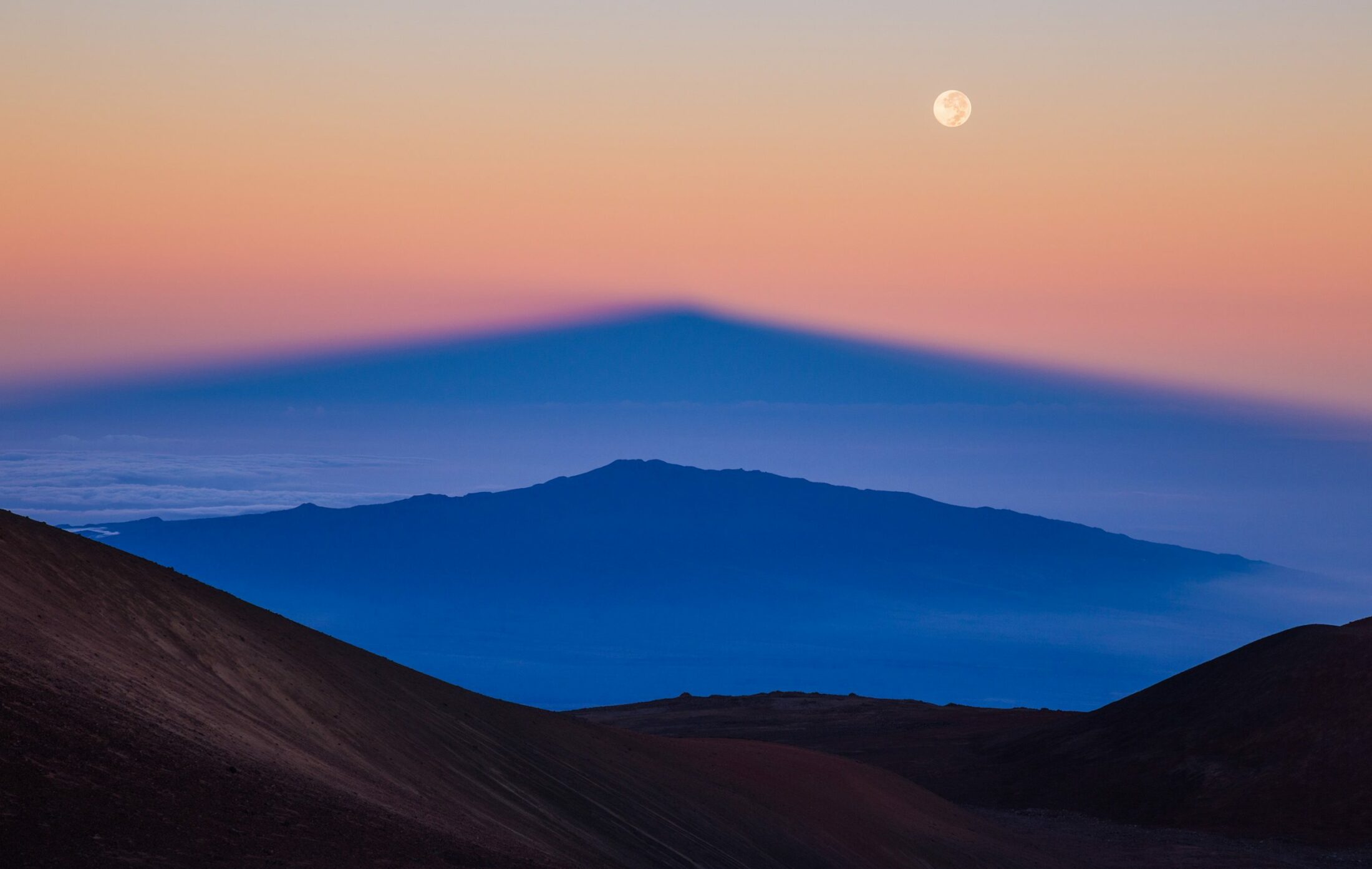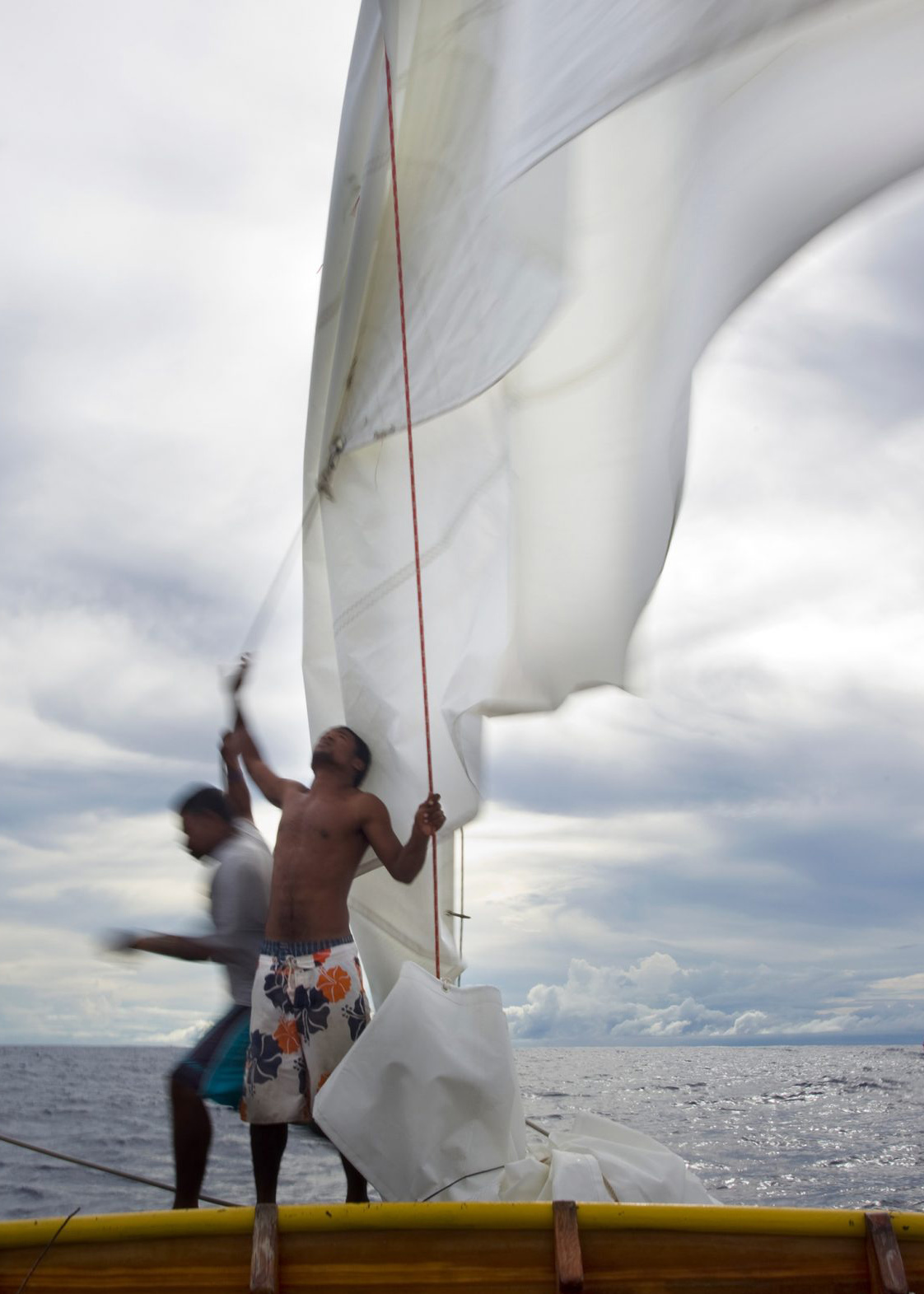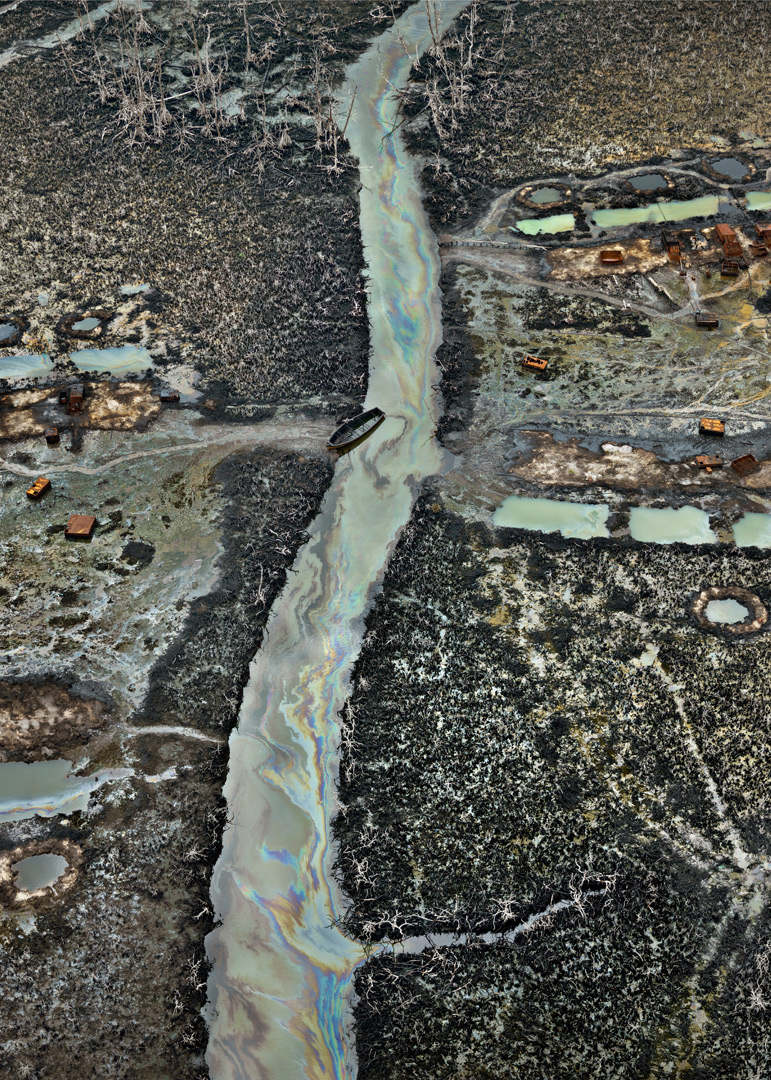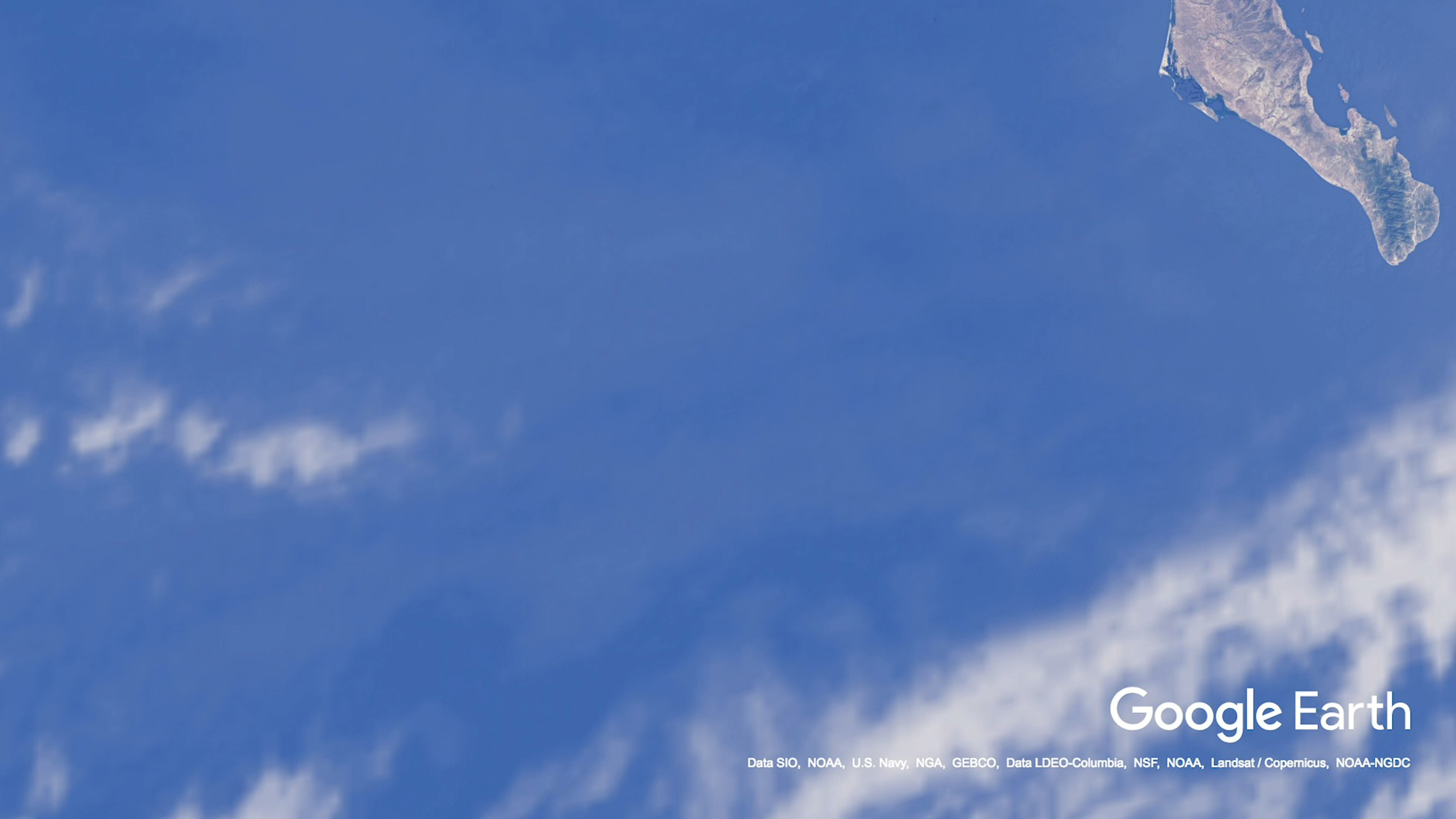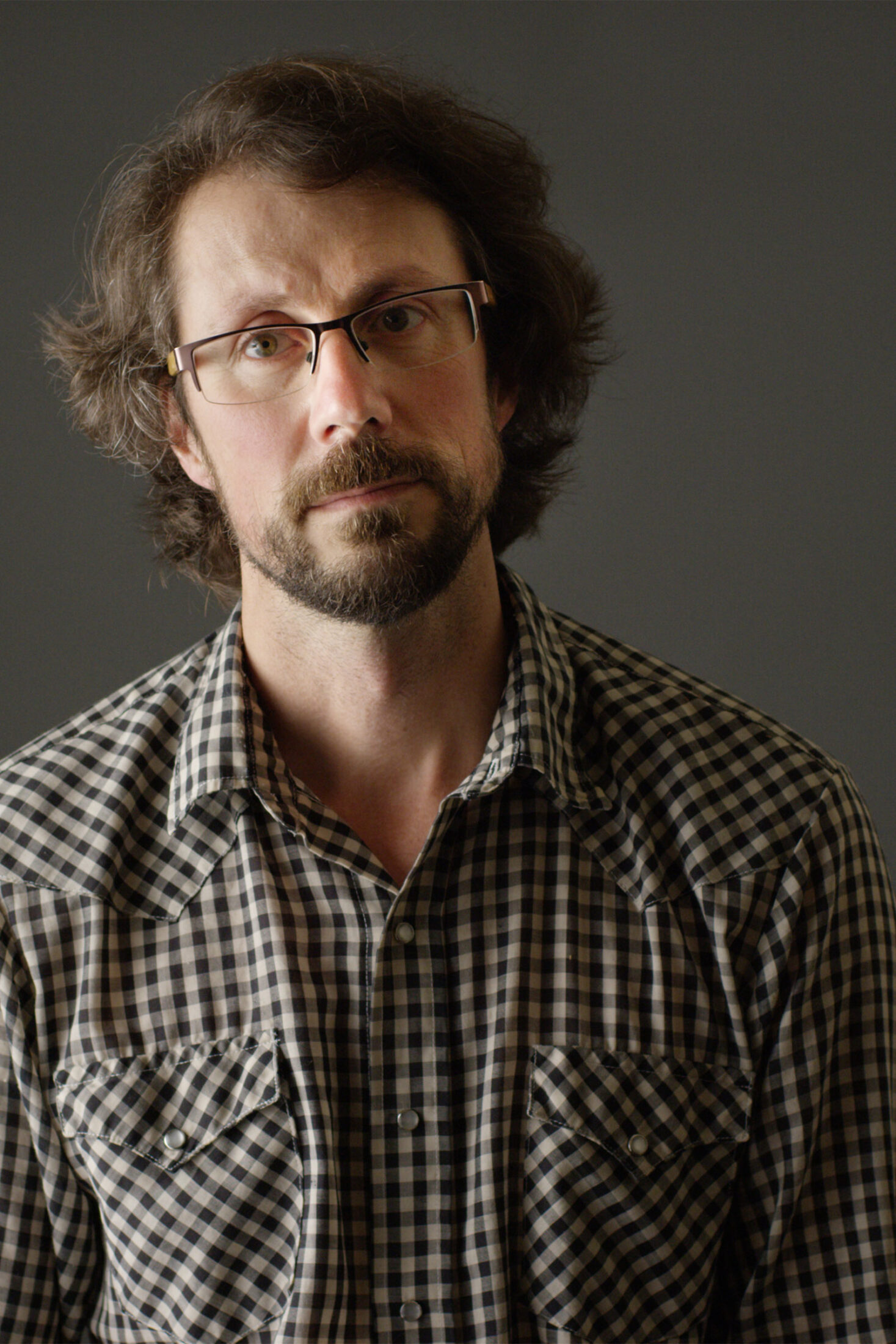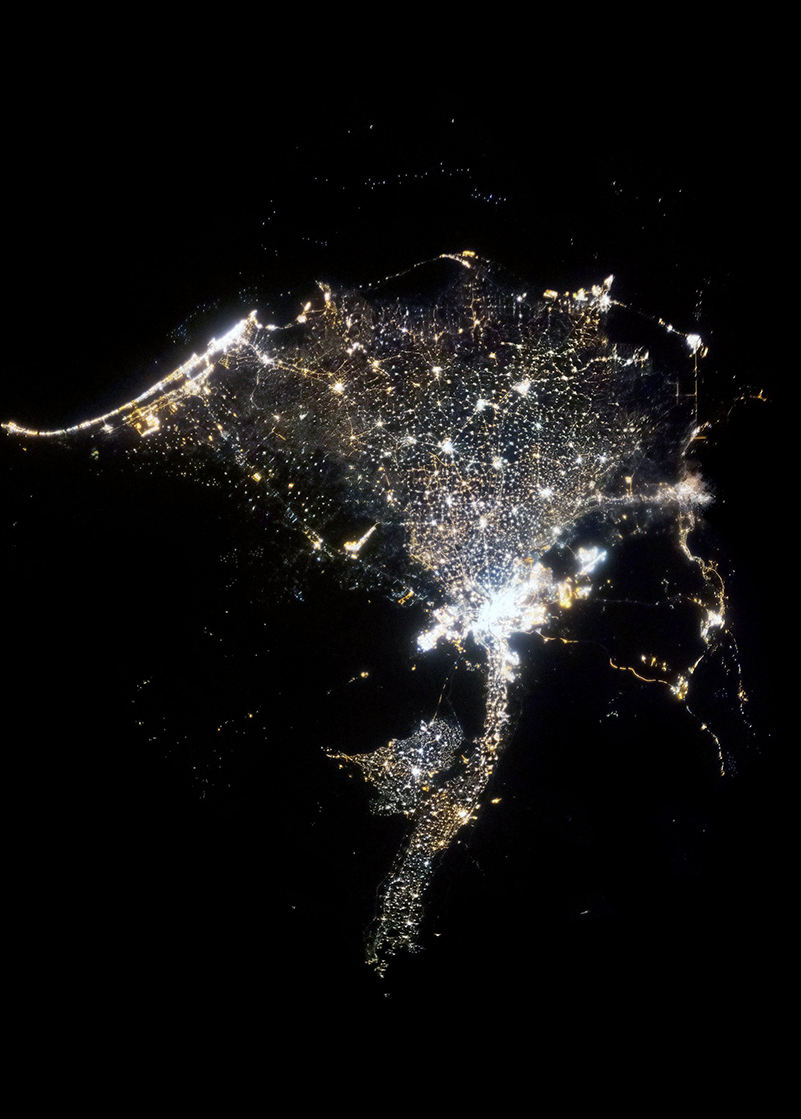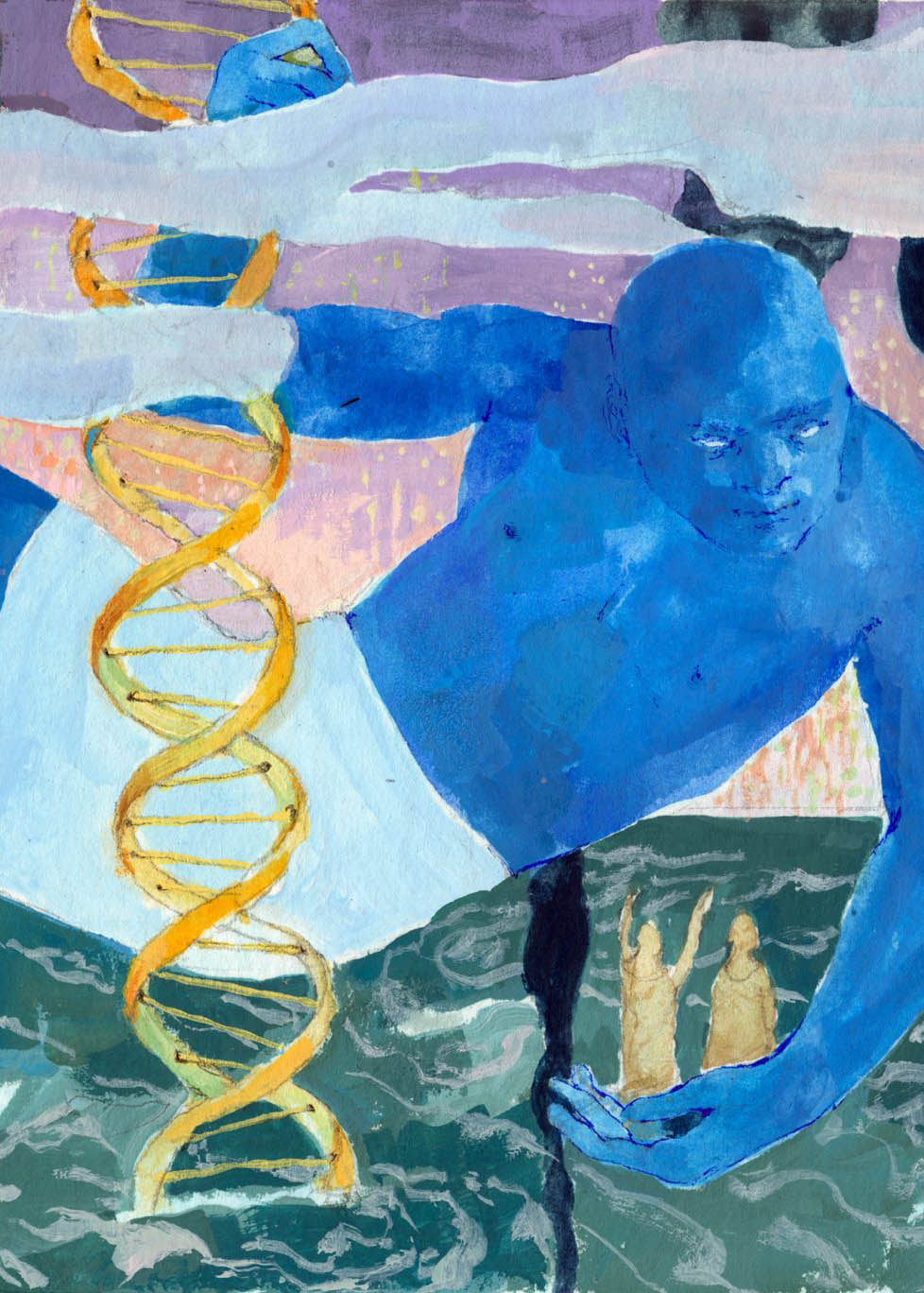
Chelsea Steinauer-Scudder is a writer based in northern New England whose work explores the human relationship to place. Her essays have been featured in Crannóg Magazine, Inhabiting the Anthropocene, and EcoTheo Review. Her forthcoming book is Rebirth: Mothering Through Ecological Collapse.
Ben Suliteanu is an aspiring filmmaker specializing in editing and sound design. He recently graduated from Stanford University with a bachelor’s degree in science, technology, and society.
In this in-depth investigative story, Chelsea Steinauer-Scudder explores the collision of values unfolding on the summit of Mauna Kea, the proposed site for what would be the largest telescope in the world.
‘O ia ho’i hā, o ka mauna. Hānau ka mauna.
So it is, the mountain. The mountain was born.
Nearly 14,000 feet above sea level, in the middle of the Pacific Ocean, on the island of Hawai’i, there is a place of snow and ice where the wind is sharp and wisps of cloud are alive in the air—illusions of breath where there is little. The land is otherworldly: iron-red and yellow and black, interspersed with the white of packed snow reflecting the strong sunlight. Cinder cones peppered with rocks rise from the undulating surface of the expansive summit with slopes that taper until they fold into the shallow circles of the small black craters at their peaks. These were the last parts of the mountain to erupt long ago, before the volcano fell dormant.
The mountain began its slow and dramatic rise from the seafloor over one million years ago, as the Pacific tectonic plate moved over a volcanic hot spot and lava erupted underwater from fissures in the earth’s crust. Eight hundred thousand years ago, it broke through the surface of the ocean. For the next half million years, it underwent frequent, violent eruptions, which transformed it into the second-largest shield volcano in our solar system. The mountain has long been dormant and still. The summit is known now for its blankets of soft snow and clear skies above the cloud line.
This is Mauna Kea on the island of Hawai’i, the Big Island. For the Kanaka Maoli, or Native Hawai’ians, it is Mauna a Wākea, the mountain of Wākea, the firstborn child of Wākea of the sky and Papa of the earth. Mauna Kea is the piko, the center or umbilical cord, the point where all energies converge. It is a place where the akua dance in their human forms, a place to chant, pray, and remember how to be in proper relationship to creation. It is the highest temple. The mountain is an ancestor to the Kanaka Maoli people, born long ago in the ongoing song of creation. For well over a thousand years, to honor this ancestor, the Kanaka kept the summit pristine, pure, and accessible only to those who ascended with the proper conduct and ceremony.
The fate of Mauna Kea and its descendants began to turn in the eighteenth century. The British Empire, thirsty for scientific knowledge and territory, sent ships to the Pacific Ocean, tracking the course of planets and searching for new sea routes. In 1778, one of those ships stumbled upon the Hawai’ian Islands, and the long memory of a people was overtaken by something different. In the late 1800s, shortly before the Hawai’ian monarchy was overthrown by American merchants, the summit of Mauna Kea, with its clear skies and low atmospheric turbulence, earned recognition as an important site for astronomical observation. Today, astronomers know it to be the preeminent place on Earth from which to gaze at the universe.
On a day in late March, the sun is making its way across the sky as the mountain’s shadow begins to flow down its eastern side, veering horizontally where it meets the clouds, which are sweeping up the barren slopes of the summit in great gusts of wind like howling day-lit phantoms. Far in the distance, across the cloudscape, the dark eye of neighboring Mauna Loa opens briefly, glaring from its own great height, before closing again in a shroud of white.
From the seafloor to the summit, Mauna Kea rises to 32,696 feet, making it the tallest mountain on Earth. The base, 18,900 feet below the shimmering surface of the Pacific, lies far below where the last of the sunlight has been dispersed in the deep water—an abyss where the cusk eel swims, at home in the cold dark.
At the true summit is a modest shrine: a mound of stacked red stones collected from the body of the mountain. Blessings and prayers—bouquets of grass, offerings wound with red thread—are tucked into the rocks, secure against the wind. Some are fresh and hold their color; others have turned dry and brittle.
Mauna Kea is the piko, the center or umbilical cord, the point where all energies converge.
As the sun sets, it catches the metal siding of a huge dome standing tall and still above its wide base: a telescope. Just beyond it is another telescope, and another: silver and white towers planted in the red rock, some of them fifteen stories tall. In 1968, the University of Hawai’i Institute for Astronomy was granted a sixty-five-year lease on the summit of Mauna Kea. To date, thirteen telescopes have been built. Driven by the wonder of discovery and the awe of gazing at the night sky, scientists have gone so far as to create machines which see further and more clearly than we ever could, which gaze in our stead, sensing neither the mountain nor our reverence for the heavens.
A long string of dark asphalt curves up the slope of the mountain. At the end of this day in early spring, observatory staff depart in four-wheel-drive vehicles, while sunset-viewing crowds arrive in vans and buses, eager to watch the light of the heavens transform into a wide swath of stars. Island vacationers shiver in borrowed coats as the temperature dips into the thirties. Come nightfall, after the crowds depart and the last light is gone, the shrine—the small mound of stones at the highest point of this dormant volcano—will fade with the mountain into the darkening sky, giving way to a vista of stars. The telescope domes will rotate open. Their searching eyes will begin the nightly ritual of peering into the heavens, far beyond the dome of the sky, searching for distant answers from atop the high and silent reaches of the White Mountain.
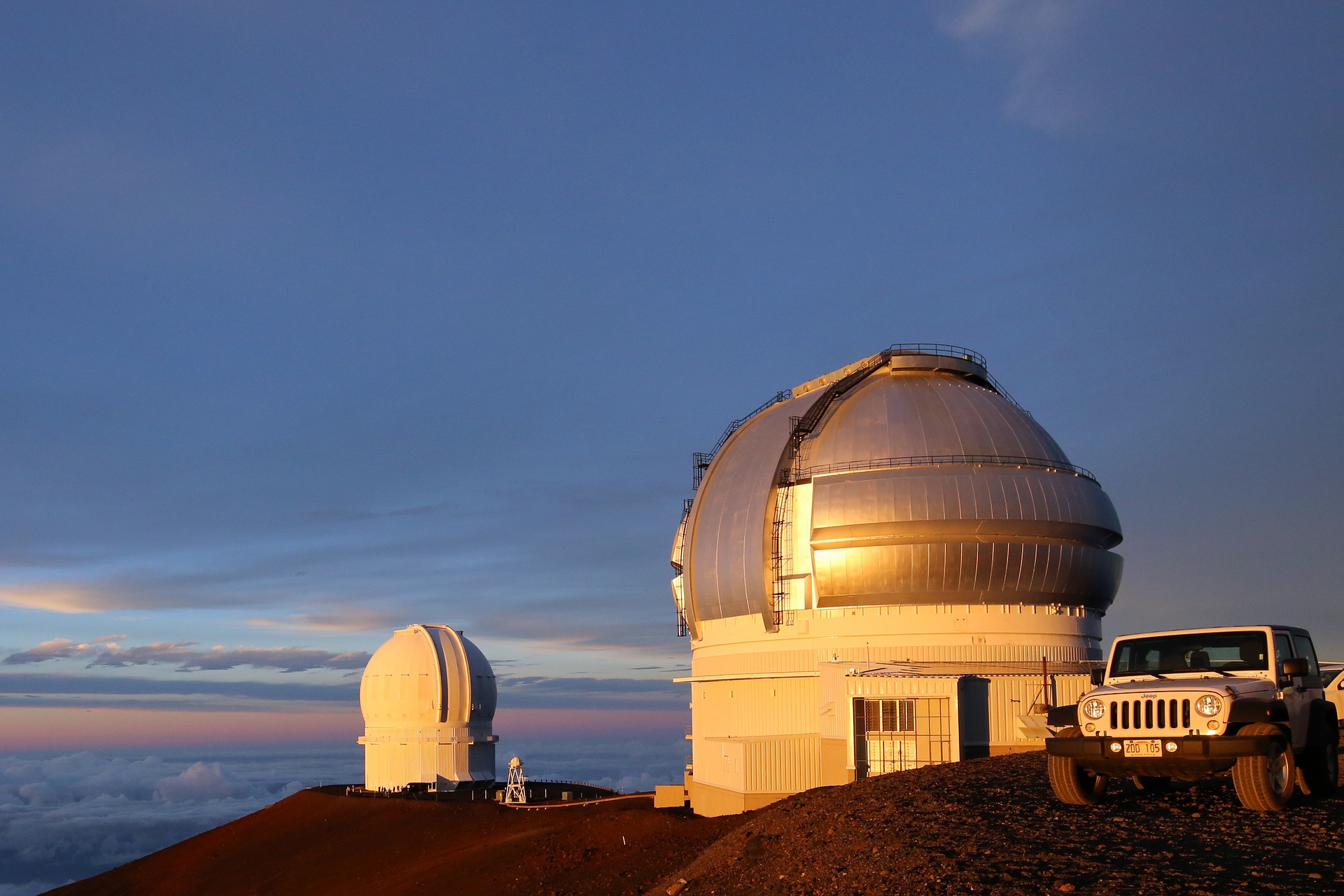
Gemini Observatory and The Canada-France-Hawaii Telescope on the summit of Mauna Kea.
On September 2, 2010, the University of Hawai’i at Hilo submitted a Conservation District Use Application to the Board of Land and Natural Resources, seeking permission to build a fourteenth telescope atop Mauna Kea. TMT, the Thirty Meter Telescope, would be at the forefront of innovation in telescope technology and would sit on the best site in the world for observing our universe. Over eighteen stories high with a dome measuring over ninety feet in diameter, TMT would enable astronomers to see ever further into the reaches of space, to perhaps discover habitable exoplanets, and to analyze with more precision the mysterious events surrounding the Big Bang. It would enable humanity to learn more about dark matter and black holes. TMT would offer what generations of scientists and astronomers have been working toward for centuries: a giant forward step in the potential for discovery, an unprecedented technological breakthrough.
To the astronomical community and much of the lay community of the Big Island, TMT was a step in the right direction. It would bring the prestige of discovery, funding for education, money, jobs, and scholarships to a struggling community. With thirteen telescopes already on the mountain, the University of Hawai’i and TMT anticipated the permit’s swift approval. They did not see what was to come, perhaps because they did not realize the extent to which many of the Kanaka Maoli have been remembering the ancient songs, recalling their role as guardians of a sacred mountain.
Pualani Case is a Kanaka Maoli woman, a hula teacher, and as a member of the Mauna Kea ‘Ohana Na Kia’I Mauna, is one of the most outspoken defenders of Mauna Kea. “What I say to those who came here first for that permit—that they thought they could just sneak in and build one more up there and we wouldn’t be watching—I say, because of you, to a large degree, you thought you were building eighteen stories, but you helped us to build a movement, and unified us at the same time. And I acknowledge that. And there are days that I actually thank you for that. But you will not build on this mountain. And that is not just me saying that, or the thousands that have joined in to say that. I believe that is because the mountain has said that.”
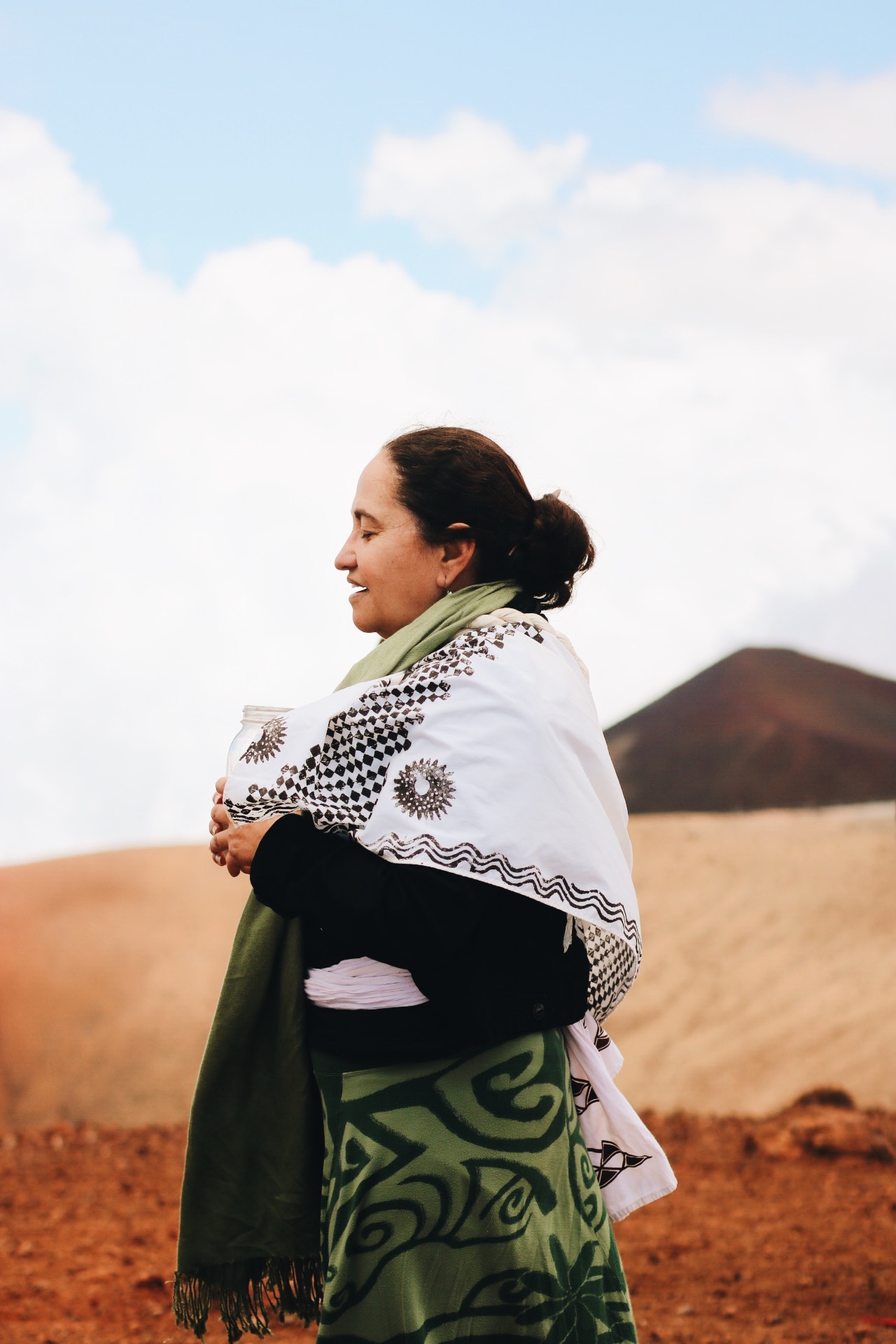
Pua Case chants on the summit of Mauna Kea.
Photo by Kapulei Flores
Growing up, Pualani, who goes by “Pua,” would gaze at the snow-capped summit of Mauna Kea, “Big Mama,” from her home in Waimea. Throughout her Christian upbringing, she understood the mountain to be an ancestor, a grandmother. Pua’s father spent his days on the lower slopes of the mountain, where Pua often joined him as he managed water for Parker Ranch, a large landholder and cattle ranch at the base of the mountain. As an adult, Pua’s relationship to the mountain has deepened as she has become more aware of her Hawai’ian lineage and her connections to the mo’o, the guardians of the streams and the rains. Now, she comes to the slopes and summit in the spirit of Ku Kia’i Mauna, standing as a protector just as the mountain does. “Every single person [who] comes to the mountain brings their own story. They bring their own experience. They bring their background, their perspective, their limitations, their burdens, their anger, their emotion. We all bring our whole self to the mauna.”
I arrive at Keauhou Bay in Kona to a parking lot crowded with the bustling activities of a hot afternoon on a Hawai’ian pier: people climbing off of sailboats amid stacks of kayaks and paddles, an instructor loudly recommending that everyone in his group use sunscreen despite murmurs of dissent. At the edge of the pavement is a small mowed lawn bordered by a low stone wall. No one seems to notice this little expanse of grass or the stone monument at its center, draped with leis and leaves. Near the monument, a faded sign is mounted on a rock: a black-and-white portrait of a man in a suit with a trim mustache and soft eyes is framed alongside a few paragraphs of text. Were anyone to read it, they would learn that this is the birth site of Kamehameha III, born Kauikeaouli, one of the beloved kings who reigned during Hawai’i’s eighty-three-year span as a monarchy. I’m here on Pua’s invitation to observe the celebration of the king’s birthday. Today is March 17, Kauikeaouli’s chosen birth date, on account of his fondness for Saint Patrick.
I spot Pua as soon as she arrives. She is easily recognizable from the photos I’ve seen of her. Her hair is wrapped into a low bun. She wears tinted glasses. Despite her short stature and pleasant, round face, I’ve seen enough interviews of her to know better than to think she has tolerance for anyone wasting her time. As if intent on proving me correct, she seems weary of my presence by the time I finish introducing myself. Soon, a group of fifteen has gathered in the parking lot. As they remove their shoes, knot large swaths of bright blue fabric across their chests, and don crowns of yellow flowers, it becomes clear they are here for something other than recreation.
The group is preparing to perform the mele hānau, the birth chant, that was composed for Kauikeaouli’s entry into the world just over two hundred years ago. They circle around Pua as she welcomes them, reminding them of the cultural importance of performing chants in their entirety—a practice that has largely been lost. This mele has been restored; they will chant all 135 lines. They line up along the pier, where Kalani Flores, Pua’s husband, blows into a conch shell. The chant begins.
‘O hānau la pō iā luna,
Hānau ka pō i luna nei.
Born was the night above,
Born was the night up here.
Until Christian missionaries arrived with reading and writing, Hawai’i’s culture was oral, with histories and knowledge preserved in chants and hula. Birth chants were composed to place the new infant into the genealogy of the spiritual, natural, and human world. As the chant continues, the chanters move across the parking lot onto the mowed lawn with the stone monument. They have drawn a small audience of onlookers who are standing around the perimeter of the site, many filming and photographing on their phones. Following the birth of the night, the island is born, green and lush. The verses of the chant pass to different members of the group as, one by one, various elements are brought into being.
O hānau ke ao, ‘o hiki ‘ae.
‘O ‘ohi ‘ae ke ao, ‘o hiki ‘ae.
The cloud was born, it rose and appeared.
The cloud thrived, it rose and appeared.
In the lines following, the sky darkens, turning black and threatening: the pangs of labor. ‘O wai lā auanei ko lalo la? the chanters call. Who shall be below? The reply:
‘O wai lā, ‘o ka Mauna ia, aia ho’i lā.
Who, it shall be the mountain there indeed.
At this, all of the chanters fall silent, apart from Lanakila Mangauil, a young man kneeling in the corner of the lawn. The sides of his head are shaved, revealing deep blue tattoos above his ears. A ribbon of dark hair runs from his forehead to the nape of his neck. He begins to beat his drum, calling out, ‘O hānau ka Mauna a Kea! At this, the others begin to beat their thighs and chests, chanting the birth of Mauna Kea.
‘O hānau ka Mauna a Kea,
‘Ōpu’u a‘e ka Mauna a Kea.
‘O Wākea ke kāne,
‘O Papa o Walinu’u ka wahine.
Hānau Ho’ohōkū he wahine,
Hānau Hāloa he ali’i,
Hānau ka mauna he keiki, Mauna a Kea.
Born of Kea was the mountain.
The mauna of Kea budded forth.
Wākea was the husband,
Papa Walinuu was the wife.
Born was Hoohoku, a daughter,
Born was Haloa, a chief,
Born was the mountain, the mountain-son of Kea.
A few verses later, the infant enters the world at last, bringing the chant to a close. The group departs, scheduled to perform the chant again at a cultural festival nearby.
“By definition, what is sacred is different for people,” Pua says. “I say a place is sacred when the chants link me to it. When I am chanting and the chant said the mountain was born and then you were—from the gods and from the goddesses, from the heavens and the earth, the mountain was born—that already tells me it holds a special, sacred place in my genealogy. I descend from that mountain, but also the mountain has taught me, has spoken to me, has shaped me, has transformed me in how I walk in this world.”
Chants such as this mele hānau affirm the sacred lineage of the Kanaka Maoli. In the face of TMT, the Mauna Kea verse has increasingly become a call to remember the proper place of the mountain and the proper role of people in relation to it. It is only after the birth of the night, the island, the clouds, the mountain, the sun, and the ocean that a child, even one destined to become a great king, may be born.
“When a place can still teach you what it is to be connected to a great people, and what you learn from [that place] you are teaching the next generation—that is a place that is sacred,” Pua says. “Where the spirit world still dwells because you feel them, you hear them, you see them, you learn from them—that to me is sacred, and that is Mauna Kea.”
He wa’a he moku, he moku he wa’a.
The canoe is an island, the island is a canoe.
Around 400 CE, a small fleet of canoes landed on the shores of the uninhabited Hawai’ian Islands. This group of Polynesian sailors had navigated across vast distances of water, guided by the position of the stars, the temperature of the ocean currents, patterns of bird migration, the direction of the wind, and the colors of the air.
For over 1,500 years, the Kanaka Maoli inhabited these islands, unaware of the goings-on of people elsewhere. People elsewhere were likewise unaware of the existence of the Kanaka Maoli living in the middle of the sea. The Kanaka created a complex society based on a hierarchical social order ruled by ali’i, or high chiefs. Extensive agricultural systems, land use, and fishing practices were guided by the kapu system. Kapu, meaning “forbidden,” was a strict structure of rituals and taboos dictating almost every aspect of daily life. Life on the islands was frequented by unpredictable volcanic eruptions, by wars and feuds, and was suffused with songs, stories, hula, and surfing competitions.
“The mountain has taught me, has spoke to me, has shaped me, has transformed me in how I walk in this world.”
In 1778, Makali’i—the ‘ohana hōkū, or star family, that includes the Western constellation of the Pleiades—arrived in the night sky over the islands, marking the beginning of the season of Makahiki, a time of prescribed peace, games, and steady rain. It had long been predicted that the god Lono would come during this season, and during this particular celebration of Makahiki, an auspicious sign appeared on the horizon: something was coming over the waters.
The arrival of Captain Cook and his crew set off a tidal wave of change that could easily have been attributed to the work of a deity. Captain James Cook’s first voyage across the Pacific ten years prior had been for scientific purposes and was commissioned by the Royal Society to track the transit of Venus across the sun. Now, charged with locating a northwest passage around America, Cook had unexpectedly encountered the Hawai’ian Islands. Tales of an exotic land, lush and fertile, found eager ears in Europe and America. Within a few short years, merchant and whaling ships were a common sight in the bays. In 1820, the first Protestant missionaries arrived with their own god. They brought reading and writing, a new way of building homes and structuring communities, and an eye for the land. King Kamehameha II converted to Christianity. His son, Kamehameha III, created Hawai’i’s constitutional monarchy and established a declaration of rights, written constitution, house of representatives, and supreme court. The United States officially recognized Hawai’ian independence in 1842, even as it continued to vie with Britain and France for control of the monarchy’s fast-growing economy.
Many of the missionaries, ship captains, and merchants who came to Hawai’i became sugar barons. By the mid-1800s, sugarcane plantations had spread across the islands. Four-fifths of Hawai’i’s arable land was soon owned by white businessmen, and Hawai’i’s economy became fully dependent on sugar. Immigrants from China, Japan, and Portugal arrived to work the plantations. Vast irrigation projects diverted streams, lowered the water table, and displaced the taro fields and fish ponds. The Reciprocity Treaty between Hawai’i and the United States in 1875 expanded the United States’ control over trade and tariffs and notably failed to ensure recognition of Hawai’ian sovereignty.
Throughout these tumultuous decades, Christian schools banned Native Hawai’ian practices and beliefs. Devastating waves of measles, smallpox, venereal disease, and influenza raged throughout the indigenous population. Newcomers to the islands predicted that the Kanaka Maoli would soon go extinct. According to some estimates, upwards of 600,000 Native Hawai’ians were living on the islands at the time of Captain Cook’s arrival. By 1920, according to the US census, the population had plummeted to 24,000.
In 1891, King Kalākaua died. He had made sweeping concessions to foreign powers, granting them both economic and military rights to much of the islands. His sister, Lili’uokalani, took the throne, inheriting a crippled monarchy bent to the will of those contending for Hawai’i’s riches. In 1893, with the islands slipping ever further from her rule and Native Hawai’ians becoming increasingly desperate, Queen Lili’uokalani attempted to pass a new constitution to restore the monarchy’s executive powers. A group of American merchants—with the backing of sugar barons and descendants of early missionaries—overthrew the monarchy. Advised to stand down to avoid bloodshed, Queen Lili’uokalani awaited the US government’s condemnation of the overthrow. But the US remained silent. Ultimately, Lili’uokalani was placed under house arrest, as the provisional government enacted laws that further disenfranchised her people.
Eventually, America did take action. Hawai’i was annexed by the United States at the start of the Spanish-American War in 1898, and the island nation passed into the hands of the United States following a faraway vote. By 1933, sugar was at the peak of its economic power. In 1959, Hawai’i was declared a state. The United States did not recognize the Hawai’ian language until 1978, nearly a century after the monarchy was overthrown.
The Kanaka Maoli have seen their lands co-opted, their language and practices outlawed, their cosmologies diluted, and the vast majority of their ancestral kin felled by disease. But the Kanaka have not gone extinct. What endured through the last centuries of great hardship, disease, and devastation were the embers of tradition and belief.
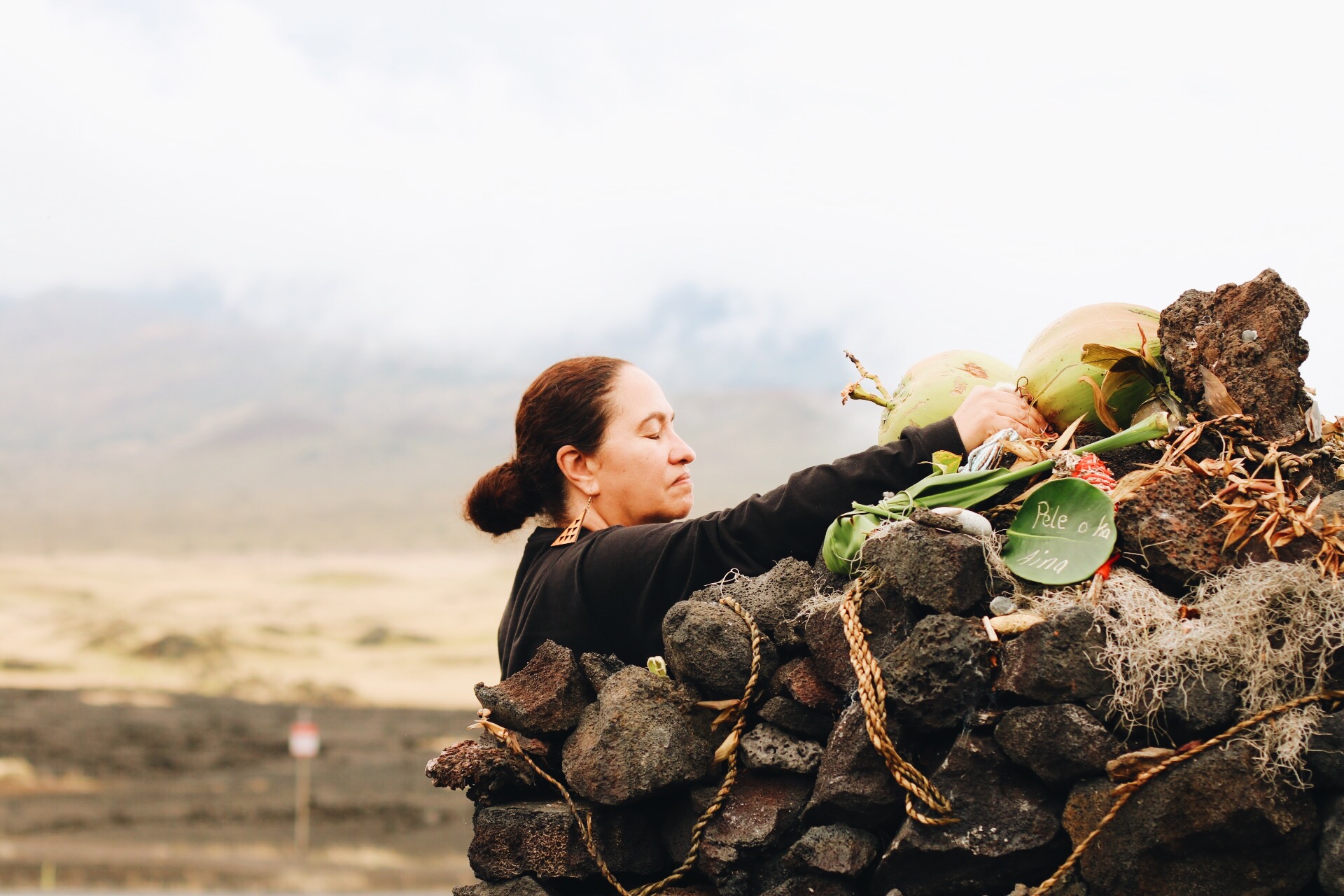
Pua Case places an offering on a shrine near the access road to Mauna Kea.
Photo by Kapulei Flores
“The disconnect is so great that, thankfully, there are first peoples of places that still have prayers,” Pua says. “There are first peoples of places that, no matter what we’ve done to them, will stand for a place even when they’ve almost forgotten how. That’s the way it is when the infiltration, the devastation, the annihilation … is so big that you almost say, ‘Wait, what was my kuleana?’ And thank goodness, at least for our people, [that] enough remained intact that we never forgot.”
In many ways, the Kanaka and Westerners coexist peacefully on these islands today. But there are distinct ways in which they remain at odds, places where there is still a rift between these belief systems. As TMT has worked its way through the courts, getting closer to Mauna Kea, one of those rifts has become a wide chasm. On one side is the science of astronomy, the pursuit of objective knowledge and technological progress. On the other side are people who are increasingly recalling their ‘ike kūpuna, the traditional knowledge of their ancestors, knowledge that still resides in chants and hula and in the stories and histories that managed to survive. Many in Hawai’i have said that there are already thirteen telescopes on the summit—what’s one more? But for Pua and others, there has been enough taking. “For me, if we let this one go … if we let this happen to the most sacred place that we know, we may as well just lay down and say, ‘Take everything if you’re going to take that.’ If we are going to allow that on our watch, then what are we saying? ‘Take all.’”
What endured through the last centuries of great hardship, disease, and devastation were the embers of tradition and belief.
I first meet Doug Simons at the ‘Imiloa Astronomy Center in Hilo, where he’s giving a presentation entitled “Astronomy FutureCast.” His talk ranges from the infinite density of black holes to his prediction that we will discover extraterrestrial life within several decades. Breakthroughs in research and technology are inching us ever closer to an elusive understanding of the universe and our place in it. Many of these advances are occurring on the Big Island, from the summit of Mauna Kea.
Doug, who moved to Hilo in 1986, serves as the executive director of the Canada-France-Hawaii Telescope (CFHT), one of the thirteen telescopes on the mountain. Doug supports TMT, whose discoveries and abilities will enhance the work that CFHT is able to do. But whatever the courts decide, he tells me, he hopes everyone can accept the outcome and move on, as the decade-long battle over TMT has taken a toll on the community. Doug hopes to see more ways to bring the whole community together on the shared ground of the mountain—what he considers the centerpiece of the Big Island—through cultural and educational programs.
Perhaps due to decades of studying the universe, Doug takes an expansive view of things. He sees science as a belief system, one which evolved along the continuum of human existence and built upon layers of culture, religious belief, and philosophy interconnected over thousands of years. “I think there’s an over-tendency in the so-called modern age to treat science, in its contemporary sense, as an end unto itself somehow, [as if] we’ve discovered the ultimate way of perceiving things,” he told me. “I wonder, in a thousand years what will replace it … and [if] people will look at [science] as … just another layer.” Indeed, the field of astronomy, in particular, has expedited drastic changes in our way of perceiving things, with a particular knack for turning what we thought we definitively knew on its head. Earth used to be the center of the universe.
Astronomy continues to push the bounds of perception. While many may conjure the image of a solitary person peering through the eyepiece of a tiered cylinder atop a tripod when thinking of astronomy, the professional field has changed significantly since the time of Galileo and Copernicus—indeed, over just the last fifty years. One of the most critical breakthroughs has been in the field of adaptive optics, developed in the 1970s. Adaptive optics (AO) corrects for blurring caused by turbulence in the earth’s atmosphere, which limits the seeing ability of telescopes. AO enables a telescope to work in concert with a high-speed camera, a computer, a deformable mirror, and lasers. Light captured while the telescope is viewing a distant galaxy, for example, is sent to a camera, then to a computer, which adjusts the deformable mirror to account for blurring. The W. M. Keck Observatory on Mauna Kea has a deformable mirror that consists of thirty-six fitted hexagonal segments that can change the mirror’s shape up to 2,000 times per second, improving the telescope’s performance by a factor of ten. TMT will be the next-level application of adaptive optics.

Keck telescope observes stars orbiting the black hole at the center of our galaxy.
Photo by Sean Goebel
These technological advances mean that, by and large, professional astronomers no longer look through telescopes to gather information, but rather “observe” from a remote screen, telling a computer where to direct the telescope and awaiting the digital arrival of data and images.
Technological advancement has also meant that telescopes have become huge. TMT, to quote TMT International Observatory, is part of what is literally called “a new class of extremely large telescopes.” Each of the two telescopes in the Keck Observatory on Mauna Kea weighs 300 tons and has a lens that spans a diameter of ten meters. TMT, if built, will be eighteen stories tall with a nearly thirty-meter lens and a footprint of over five acres, which includes outbuildings and access roads.
TMT has a backup location in Spain’s Canary Islands. But, as astronomers’ thinking goes, if you’re going to build the best telescope, you want to put it in the best location. Observing from Mauna Kea is second only to launching a telescope into outer space, which is ten times more expensive than TMT’s $1.4 billion price tag. Mauna Kea’s location in the middle of the Pacific Ocean frees it from the surrounding light pollution. Its height and the fact that there are no other tall mountains in its vicinity leave the night sky above largely void of atmospheric distortion. Its stable and cool temperatures make for stable equipment. For the University of Hawai’i and the other observatories to stay ahead of the curve and remain relevant in astronomical research and discovery, continuing to observe the universe from Mauna Kea means putting increasingly larger and more complex structures atop its summit.
Thus the encounter that began during the season of Makahiki 240 years ago continues today on the summit of the world’s tallest mountain. Each side has stories that it tells itself about its relationship to the mountain. “I can fairly easily see how the sociology of the people on the island is molded by the one thing that we all can see,” Doug says. He believes that Mauna Kea can draw people together, and that these stories can coexist if one is able to step back and look at them as points in the ongoing story of the human experience. “I don’t feel like there’s a betrayal of some sort by trying to support all of them. It’s all just part of the tapestry of modern Hawai’ian culture, from my perspective. We can revere the mountain for a whole range of reasons. They’re all right. They’re as diverse as there are people who hold those truths dear.”
But for many, not all stories are equal.
“If you’re from England, Captain Cook discovered Hawai’i. Good. That reads good in England,” Paul Neves, one of the Mauna Kea hui, or defenders of the mountain, tells me at his halau in Hilo. “We found Captain Cook on our shoreline in your year 1778, during the reign of Kalani‘ōpu‘u, who was the king here. That’s when we found you.”
The encounter that began 240 years ago continues today on the summit of the world’s tallest mountain.
If it’s an art to move with a graceful ease between the profound and the irreverent, Paul Neves is a pro, speaking barely above a whisper in a warm, rasping voice. One moment, he’s softly singing a Hawai’ian lullaby, keeping time with speckled shells. The next, he’s lamenting that Christians—he is one—read the Bible “from the ass-backwards,” launching into the tale of an Italian priest in Beijing who used Forrest Gump as a metaphor for thinking outside the box.
Paul has short, white hair and a face worn into permanent lines of smiling. He’s a Kumu hula, a master hula teacher, a Catholic, and a member of ROOK I, the Royal Order of Kamehameha I, meaning he is a Kanaka Maoli descended from one of Hawai’i’s great kings. He has testified and organized against TMT as the case for the telescope has worked its way through Board of Land and Natural Resources (BLNR) hearings and the courts.
Paul was trained by a lineage of hula masters. Kumu means tree or source, he tells me. Paul’s halau, his hula school, is based in his home in Hilo. It is simple and sparse: one large room, bordered by a wide wooden deck. Drums, gourds, an upright bass, a guitar, and a ukulele are stacked along the walls. The center of the room features only the large rug and plenty of space to dance. Birds chirp in white cages. Every few minutes, a sleepy Labrador lumbers across the floor, finding a new place to lay down with a contented sigh. The chickens occasionally have to be chased off the porch. It’s the first time the sun has been out in weeks, Paul tells me.
“Hula was a way of telling the story. It’s storytelling…. Hula’s the living library. [People] remembered those chants, remembered those stories. That’s how [they] marked time.” Hula is not about the individual, Paul says. It’s an acknowledgment of the divine breath, the aloha, that is at the heart of everyone and everything. Hula and aloha, for the Kanaka Maoli, are vastly more than pretty dances and friendly greetings. They are codes of conduct, a divinely established system of protocol. Hula preserves and tells the stories. Aloha is unconditional love, a state of being that emerged with creation itself.
Taking a break in our conversation, Paul asks if I could help him fix the lele, the altar, in his yard. He and his fellow members of ROOK I are preparing for the spring equinox ceremony. Paul’s house will be the first stop on a night-long ceremonial journey, which will culminate at the summit of Mauna Kea. The triangular shrine consists of three long branches knotted together with twine that come together at a point. A wooden platform is tied at each corner to one of the posts, several feet off the ground: a place for offerings. I hand Paul long threads of twine as he reties and secures the beams. Humans should only access the mountain in a state of prayer and reverence, Paul believes. He is not against astronomy, he assures me, but telescopes have no place on a sacred mountain. “When you go to Mauna Kea, and when you’re part of that understanding, I say no, it cannot coexist. We coexist here at sea level…. We’re going to have to figure out how to coexist here, because this is where human beings are supposed to be. [Mauna Kea] is not where human beings are supposed to be. That’s where Akua [is]. Akua is god. Kua is your back; Ah is the fire: the fire at your back, that which inspires you.”
Hawai’ian intelligence, Paul says, is from the na’au, the stomach. Technology has its place, but there are other, more reliable ways of knowing and being; the mind is only a database. Na’au is felt, intuited, learned over time through interaction with the surrounding world. It is about coming to understand the signs around you and aligning your practices and lifestyle accordingly. Development on Mauna Kea, for Paul, is symptomatic of placing too much emphasis on the intellect, forgetting to be in a felt, reciprocal relationship with what is around us. In this sense, astronomy is part of the same mindset that led to the overthrow of the monarchy in 1893. “You come here, you steal my country, you ban my language, you tell me my church, my religion, is not worth a piece of shit, you put a flag up on a pole and call me yours,” Paul says. “See, when you’re on that side—when you’re on the telescopes’ side—you don’t know the abuse, because you’re not feeling the abuse. They’ll even say, ‘Oh, we agree Mauna Kea is sacred.’ Really? Can you please tell me what your interpretation of sacred is? What does sacred mean?”
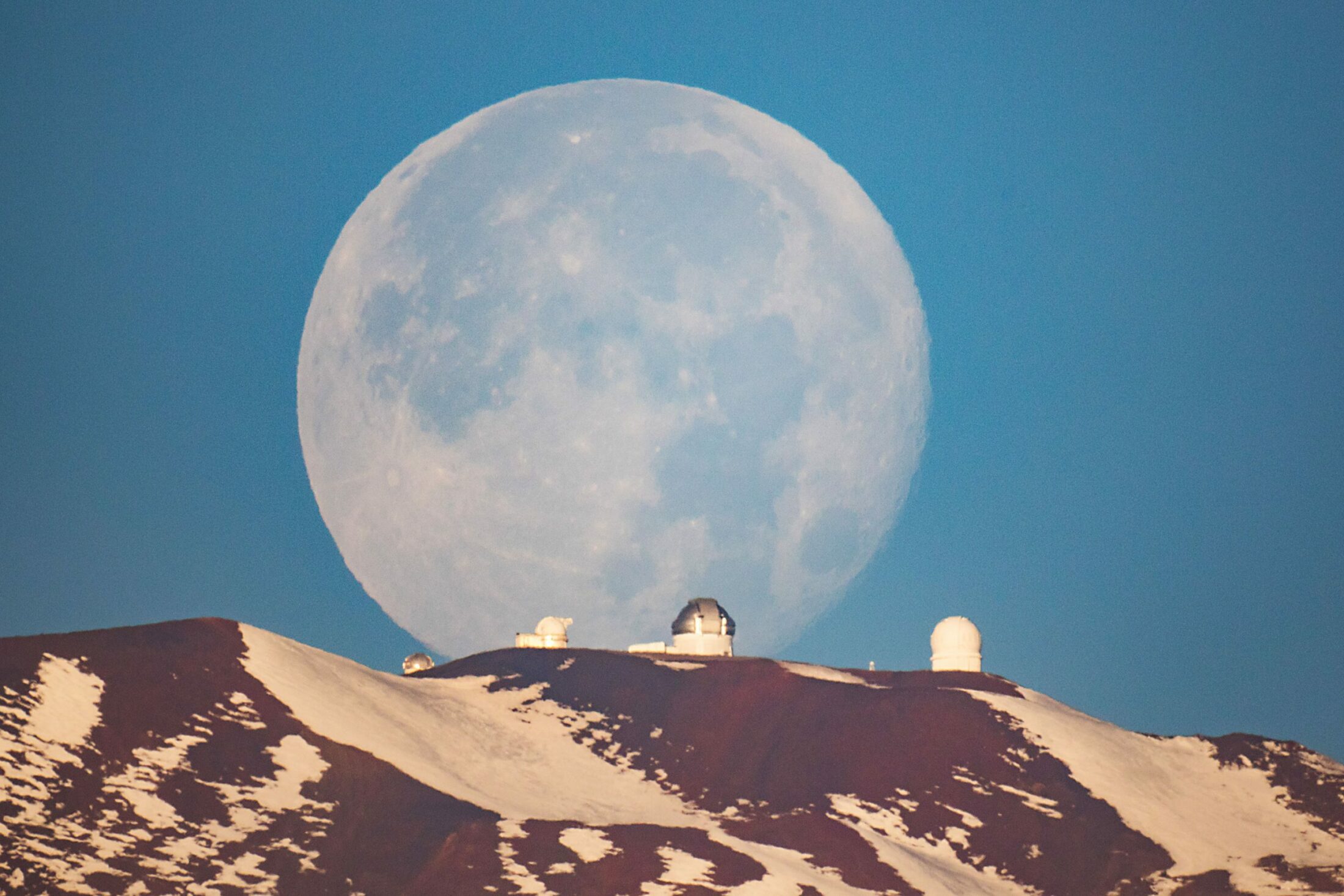
Photo by Sean Goebel
Through everything, the hula traditions have held on. Kumus continue to train their haumāna, or students. Many of the stories and songs have been passed down through the generations, and many new ones are being composed. “When [my students] come to hula, they will stand here in the front of the door, and they will put their hand to their piko, where their belly button is. The belly button is their ancestor. They’re saying, ‘My ancestor is asking me to ask you for permission to come in and be taught.’”
Later that evening at Paul’s hula class, his students chant in unison, seeking permission to enter. Paul chants back, welcoming them inside. Over the next several hours, as Paul sits on the floor with his drum, sweet harmonies swell in the room, bare feet move over the floor, and the stories and songs carry into the night.
Since the University of Hawai’i’s Institute for Astronomy secured a sixty-five-year lease on Mauna Kea in 1968—a decade after the Admission Act was passed, granting the State of Hawai’i ownership of all lands ceded from the monarchy—the Big Island has become a hub for the international astronomical community. Currently, eleven countries are directly involved in the island’s various observatories. Billions of dollars have poured in to fund the thirteen telescopes that sit atop the summit. From Mauna Kea, scientists have made breakthrough discoveries about dark energy, the accelerating universe, and the black hole believed to be at the center of our galaxy. More and more people come to the mountain every year, both for astronomy and, increasingly, for tourism. With improved roads, anyone with a four-wheel-drive vehicle can access the summit. Every year, approximately 300,000 people pass through the Mauna Kea Visitor Information Station.
There is an 11,288-acre science reserve atop Mauna Kea, leased to the University of Hawai’i from the State of Hawai’i. Of that, 10,763 acres are protected from development as a Natural/Cultural Preservation Area due to the region’s status as both a fragile ecosystem and cultural site: The summit of Mauna Kea is an arid alpine desert, home to several endemic species of lichen, as well as the endangered Wēkiu bug. Archaeological surveys have identified shrines, burial sites, and an ancient adze quarry on the south slope. Such protections are limited in scope to scientific data and historical fact. Astronomy is the only permitted use of the Mauna Kea Science Reserve. The state has designated 525 acres as the Astronomy Precinct, within which construction and development are allowed with the approval of the Board of Land and Natural Resources.
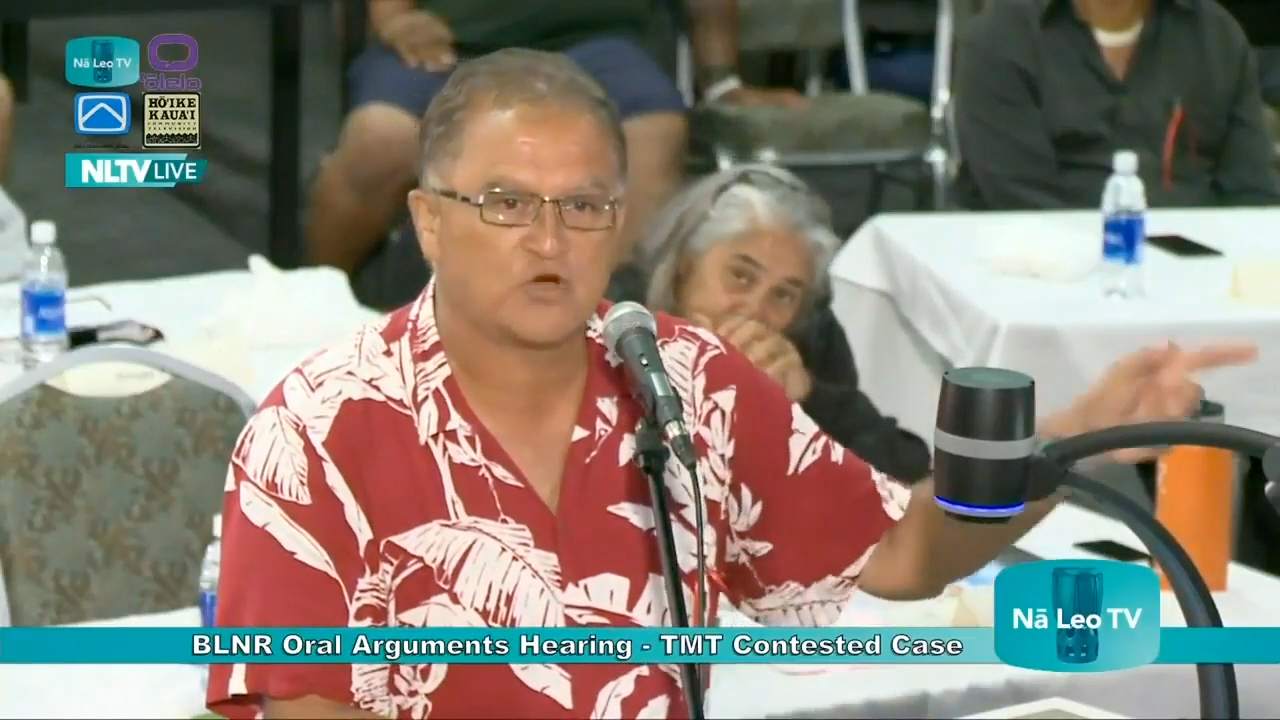
Paul Neves delivers closing arguments at BLNR hearing.
Video courtesy of Big Island Video News
The University of Hawai’i submitted a Conservation District Use Application for the construction of TMT in 2010. During a series of public meetings that December, the BLNR approved the permit pending a contested case hearing. Following the hearing in February 2011, the board officially approved the permit, a decision immediately appealed by Kealoha Pisciotta, Paul Neves, and other members of the Mauna Kea hui who are fighting against TMT and other astronomical development on the mauna. The Third Circuit Court sided with the board, but protestors halted the official groundbreaking of TMT in October 2014. On December 2, 2015, the State Supreme Court revoked the building permit, citing a failure of the board to guarantee due process in their hasty pre-approval of the permit ahead of a contested case hearing. Several long years of hearings and testimony followed, and the BLNR again voted to approve the permit in September 2017.
There are eight criteria for land management in the Science Reserve, which outline conditions that must be met for permissible land use. Criterion Four states that “the proposed land use will not cause substantial adverse impact to existing natural resources within the surrounding area, community, or region.” The only federal-level environmental review that has been undertaken on Mauna Kea since the Astronomy Precinct was created was completed by NASA in 2002, when they conducted a Federal Environmental Impact Statement (which they did only after they were sued by the Office of Hawai’ian Affairs for failing to do so previously). Quoting Criterion Four directly, the report concluded that “the cumulative impact of thirty years of astronomy development atop Mauna Kea has resulted in ‘substantial, adverse and significant’ impacts to the cultural and natural resources of Mauna Kea.”
Criterion Four has become one of the strongest legal sticking points in the case against TMT. The petitioners have called on it repeatedly in their opposition to further development on the summit. But the BLNR’s over-three-hundred-page decision, which approved TMT’s construction in 2017, rules that “the record also lacks any evidence, reason, or coherent argument that the TMT, added to the previous observatories, will create a tipping point where impacts become significant.” In other words, though TMT will likely have an adverse impact, it will not, legally speaking, adversely impact Mauna Kea beyond the documented level of damage already done.
In addition to arguments based on the eight criteria—all of which the board found unconvincing as a case against TMT—many of the testimonies from the opposition focused on desecration of a sacred place. There are many hours of recorded testimony and many more pages of written testimony in which students, professors, and community members attempt to convey to the board and the University why Mauna Kea is a sacred site that is not to be developed, even for scientific purposes. Some of these testimonies verge on pleading. But desecration of a sacred place has proved even harder to successfully argue in a court of law.
“You need to become the place, not expect the place to bow down and become you.”
I first saw Lanakila Mangauil in a video, in which he single-handedly disrupts TMT’s groundbreaking in October 2014. The scene begins with the peaceful monotony of an official event: attendees in leis are seated quietly in folding chairs partway up the mountain. Up marches Lanakila, barefoot and bare-chested in traditional Hawai’ian dress—and furious. Pacing in front of the stunned audience, he lectures them, demanding: “Where are your sacred temples?” The podium next to him with a sign reading “TMT International Observatory” remains empty for several long minutes, while the audience remains seated and silent.
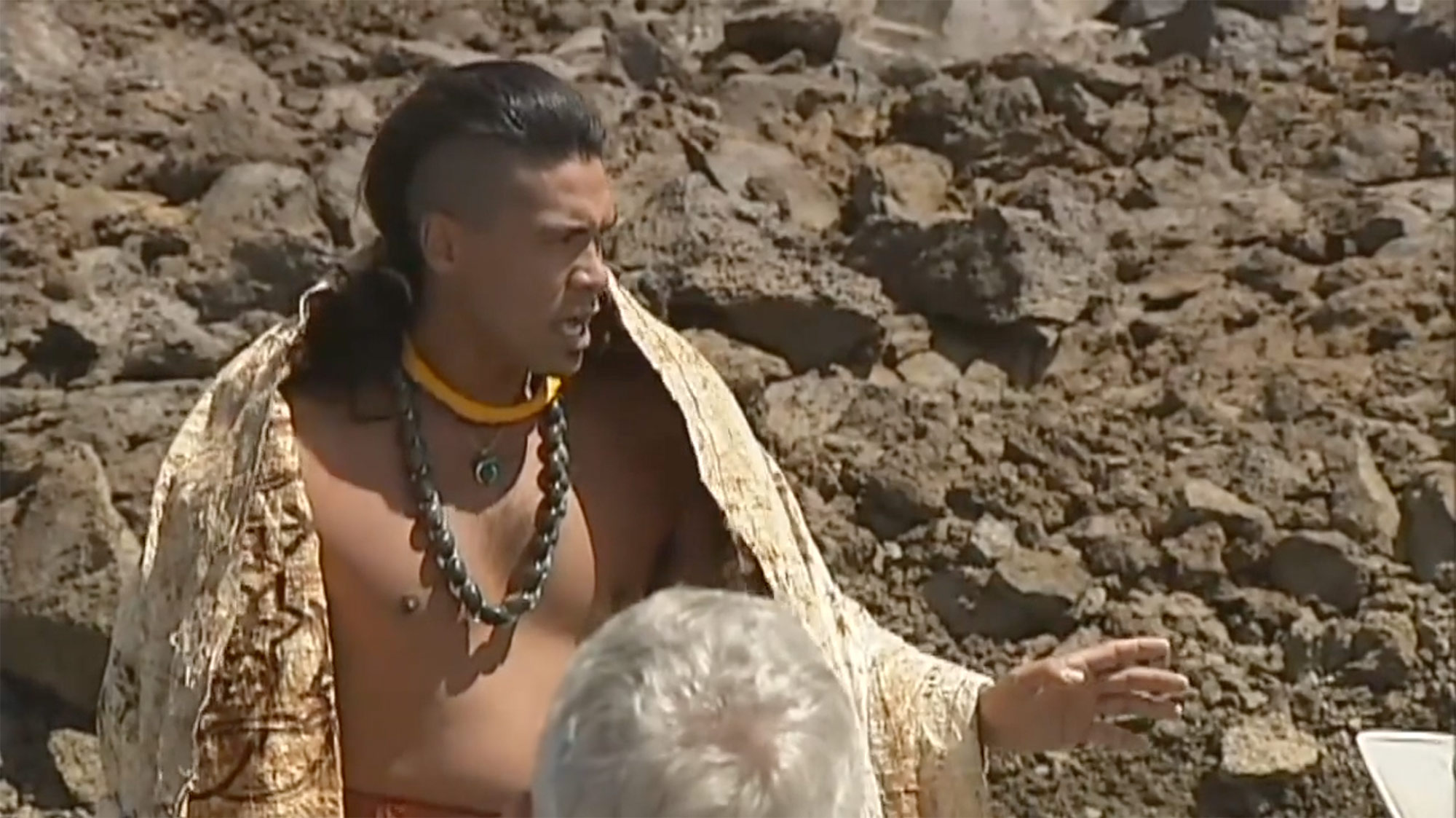
Lanakila Mangauil halts the TMT groundbreaking.
Courtesy of David Corrigan (For full video click here)
Several days after the mele hānau for Kamehameha III in Kona, I meet Lanakila at the Hawai’ian Cultural Center of Hamakua, a nonprofit he founded in his home community. I’d been expecting someone serious and somber—the sort who halts groundbreakings—but he is instead relaxed and friendly, regretting that he wore a bright green T-shirt on a day he was being photographed.
Lanakila helped choreograph the hula for Kamehameha III’s mele hānau. While working as a Hawai’ian studies teacher at the local elementary school, he decided to teach his students stories about Mauna Kea and began searching for chants. He eventually found the Mauna Kea verse of the mele and choreographed a hula noho, a sitting dance, for his third graders. As more and more people have joined in protests against TMT in recent years, the verse and its corresponding hula have taken on new meaning and significance. Others have wanted to learn, and Lanakila has taught them. Once, while on a scheduled trip to Europe, Lanakila was watching a live-stream video of protestors on the Mauna Kea access road, blocking the passage of trucks. As they began chanting the Mauna Kea verse, the camera panned to his mother, a “late-sixties Irish-Scottish lady from Colorado,” beating her chest and thighs in the motions of Lanakila’s hula. He burst into tears, unaware that she was on the mountain.
The Cultural Center’s two large rooms are occupied by the Kukulu exhibit, a colorful snapshot of protests and gatherings on behalf of Mauna Kea: paintings, photographs, T-shirts, painted signs, a battle-worn Hawai’ian flag, and Pua Case’s tattered boots, wrapped in ti leaves. Kukulu, pillar, was a collaboration between Lanakila and Pua. “Kukulu ku Ohana, the coming together of many to complete a common task,” Lanakila says. “That’s what this place is…. Many of us here, directly or indirectly, [have all been] part of the mountain.”
Lanakila was born in Honokaa, on the Big Island, where he grew up working the taro fields and learning the hula traditions. He descends from the Kanaka Maoli on his father’s side and, from an early age, was part of his community’s cultural resurgence. “[It was] my parents’ generation and the generation before who realized that something was really, really wrong—that we were losing our traditions as a people, we were losing our connection to our lands.” Lanakila started the Center as a way to sustain traditional learning in his community. Honokaa is in the district of Hamakua, as is the summit of Mauna Kea. “These are our lands. From the days of old, the ancient stories that connect us to the people of Hamakua had a particularly strong connection and a responsibility to Mauna Kea…. We were worshippers of Poli‘ahu.”
Poli‘ahu, a goddess whose physical manifestation is the snow, was placed on Mauna Kea by her father, Kāne. In the old stories, she is so pure and so beautiful that no mortal is allowed to look upon her. “What does that [story] translate into?” Lanakila asks. “What is it not to taint the snow? … We will not contaminate that.” In the kapu system, only the highest chiefs and priests were allowed on the summit of the mountain; only they could access the realm of the snow. “That’s what that kapu was all about, to keep that very small and limited space pristine.”
For Lanakila, placing telescopes on the summit of the mountain is an act of desecration with spiritual and ecological consequences. TMT will be no different, despite promises of better and cleaner management. “They want to argue with us that this building’s going to be better, but on the other side of their mouth they [say], ‘Well, if it’s so damaged, what’s one more?’ Such colonization. We’ve already stabbed you five times—thirteen times in this case—what’s one more? That’s a sickness.”
“I want to argue and continue arguing that creation still continues—it’s just that no one is singing the song.”
For those who think that this is an isolated incident that will blow over once the courts make their final decision, they need but visit the Hawai’ian Cultural Center of Hamakua. Something much larger is growing from this conflict. This has become the headquarters of a movement, a quest for a different way forward.
“You need to become the place, not expect the place to bow down and become you,” says Lanakila. “You fit into the natural cycles of the place, you fit into the flow of that land. The land, the way the river moves, the way the wind blows, the trees that grow there, the animals that live there: they are what makes that place alive. Aloha is to love. Aloha is alo he alo, face to face, to know the ha, the breath of life … to recognize individuality, but in individuality, understand connection and responsibility…. It’s not that we don’t know how. We all know how. All of our ancestors, from all walks of life, from every corner of this planet—they knew how.”
As the rain falls in steady torrents outside, Lanakila and Pua are preparing to meet with a group of young activists over lunch at the Center. A clatter of notes flies from the piano in the other room, disrupting the quiet atmosphere.
Pua was not yet involved with TMT when her daughter approached her, telling her that Mo’o-i-nanea, the spirit guardian of Lake Waiau on Mauna Kea, had come to her with a message. In the Hawai’ian cosmology, mo’o are spirit beings, often family guardians. They are shape-shifters that can take the form of lizards, sharks, turtles, human beings. Pua asked what the message was, and her daughter relayed it: Try to stop the telescope from being built. Pua was immediately afraid. She had been involved with enough legal cases and grassroots efforts on behalf of Hawai’ians to know what was likely to come from taking on such a cause. Today, Pua and her husband, Kalani Flores, make up the Flores-Case Ohana, the petitioner in the case against TMT who is responsible for TMT’s last two appearances in front of the Hawai’i Supreme Court. Pua has become a leader in the movement, spending most of her waking hours organizing, teaching, writing, speaking, and chanting on the mountain’s behalf.
The backlash she had anticipated came strong and fast. “Those corporations, those educational institutions, who thought [that] just by saying that they had a right to our places—who are in shock because we’ve dared this time to stand, [are saying,] ‘What? They are standing in the face of educational opportunities? Economic development? Science?’ None of that is more important to me than what the next seven generations will inherit. And if you are doing damage to my Hawai’i, to our Hawai’i, because of what you are attempting to do, then the answer is no. And don’t try to manipulate us, bully us, force us—and the worst is make us feel guilty. And the way that they are able to do that is to say, ‘We’ll give you some scholarship money.’ That one always gets us. Parents are very quick to change their mind when you put scholarships and funds and education in front of them, and I don’t blame them, because I’m a teacher.”
Pua is working with others to build the kukulu of tradition, protocol, and conduct, founded on the principles of Aloha ʻĀina, love of the land, and Kapu Aloha, acting with restraint and kindness. The path forward will not be an easy one; she knows what she is up against. But she is committed. “Do not let the word aloha fool you. We are fierce in our love for this land.”
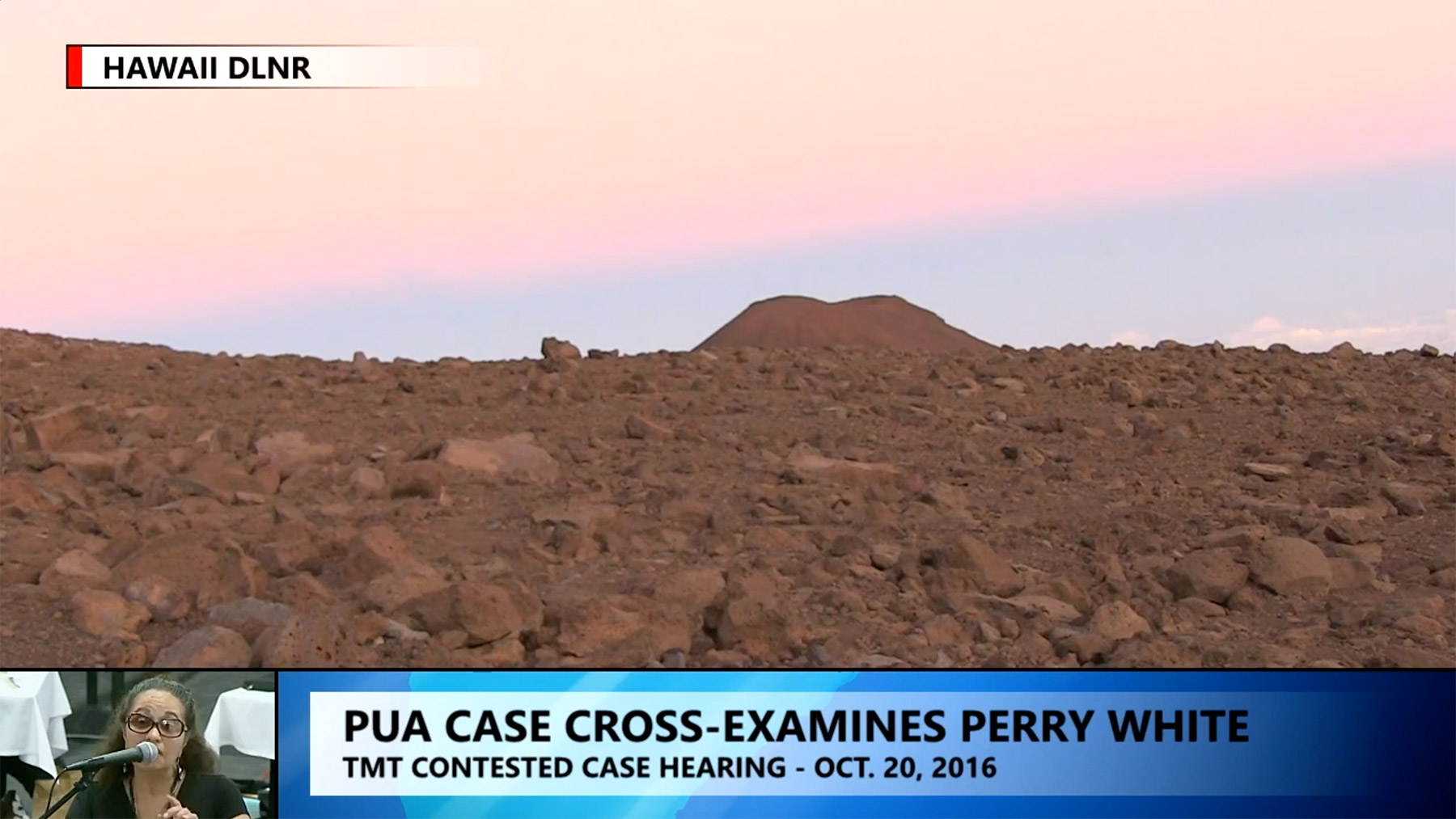
Pua Case cross-examines Perry White.
Video courtesy of Big Island Video News
Kealoha Pisciotta is in the middle of a thought when an eerie, mournful sound fills the room. She apologizes. “That’s my phone. It’s the lonely whale.” The 52-hertz whale is an unidentified species of whale that sings at an unusual frequency. Kealoha made his song her ringtone. “I’m not sure what’s happening with him, but I want him to know that we hear him.”
Kealoha is a Kanaka Maoli and one of the Mauna Kea hui. She runs the organization Mauna Kea Anaina Hou, and since 2004 has been one of the most active voices, both in the courts and out, against development on Mauna Kea.
After college, Kealoha worked as a technician for the Caltech Submillimeter Observatory and as a systems specialist for the James Clerk Maxwell observatory on Mauna Kea. A physics major, Kealoha was excited to unite her interest in astronomy with her cultural practices. But when developers started to level the pu’u, or cinder cones, on the summit to build the larger observatories, something began to shift. “It was no longer man in a large landscape. It was man destroying the large landscape to mold it in [his] own image…. Once it shifted, it’s almost as if there was just no turning back.”
During her decades as an activist, Kealoha has delved deeper into her Native traditions. She has found a particular affinity for the Kumulipo, the Hawai’ian creation chant. The Kumulipo is over two thousand lines long and begins in po, a period of infinite darkness and infinite potential. “There are two po’s in our cosmology,” says Kealoha. “One is the highest heaven, the darkest part of space, and [the other is] the darkest part of the ocean; those two places are where creation begins and evolves out of.” The Kumulipo tells the story of the unfolding of creation, eons of time in which life came into being. “It’s showing how all things exist and derive from that darkness, from the ocean and from the first coral polyp, or uku, on down to every complex mammal, and then humans. And so nearly everything—every plant and animal—was created before man. It sets up the dynamics of our Creator and the regenerative gods and goddesses that propagate throughout the world along with man…. Mauna Kea represents that po, the entrance way.”
Hawai’ians and scientists alike have marveled at the parallels between the Kumulipo and the theories of the Big Bang and evolution. In both cosmologies, everything begins in an infinite darkness with the potential for astounding energy. Much later, life on earth slowly emerges from the depths of the sea.
Many have argued that the Kumulipo is evidence for the coexistence of astronomy and Hawai’ian culture on Mauna Kea. Kealoha sees it differently. In the chant, Akua, the creator, sings human beings into existence, instilling in everything the life force of aloha. When the Kanaka Maoli sing the Kumulipo and other chants, and when they dance hula, they are reconnecting to the original divine vibration and breath that infuses everything. Chanting and dancing, Kealoha explains, are embodiments of ha, breath, and aloha, infinite love and compassion. It is both retelling and participating in the story of creation. “They say when the akua [gods] dance on the earth in their hula form, they are returning the land back to the perfection that it was the day it was created. That’s why we call them in, to ask them to come to be with us and to do this dance and restore that righteousness.”
In this ideology, development on Mauna Kea that places the will of man ahead of the will of creation is not pono, it is not balance or right action. “The ancient songs live strongly in our heart, and in our intuition and our knowing. We’ve got to know we’re not in the position to destroy creation or to join in de-creation.” For Kealoha and the other hui, the telescopes on Mauna Kea have come to represent progress and modernity again overstepping their bounds, trespassing into places they should not go, and asserting rights over something that does not belong to them or to any human being. “[It’s] the machine clanging, attempting to drown out that song of creation … [the] battle going on between the songs of modernity, trying to suppress the very ancient, older songs of our creation and of our reverence for—and the joyousness of honoring—creation.”
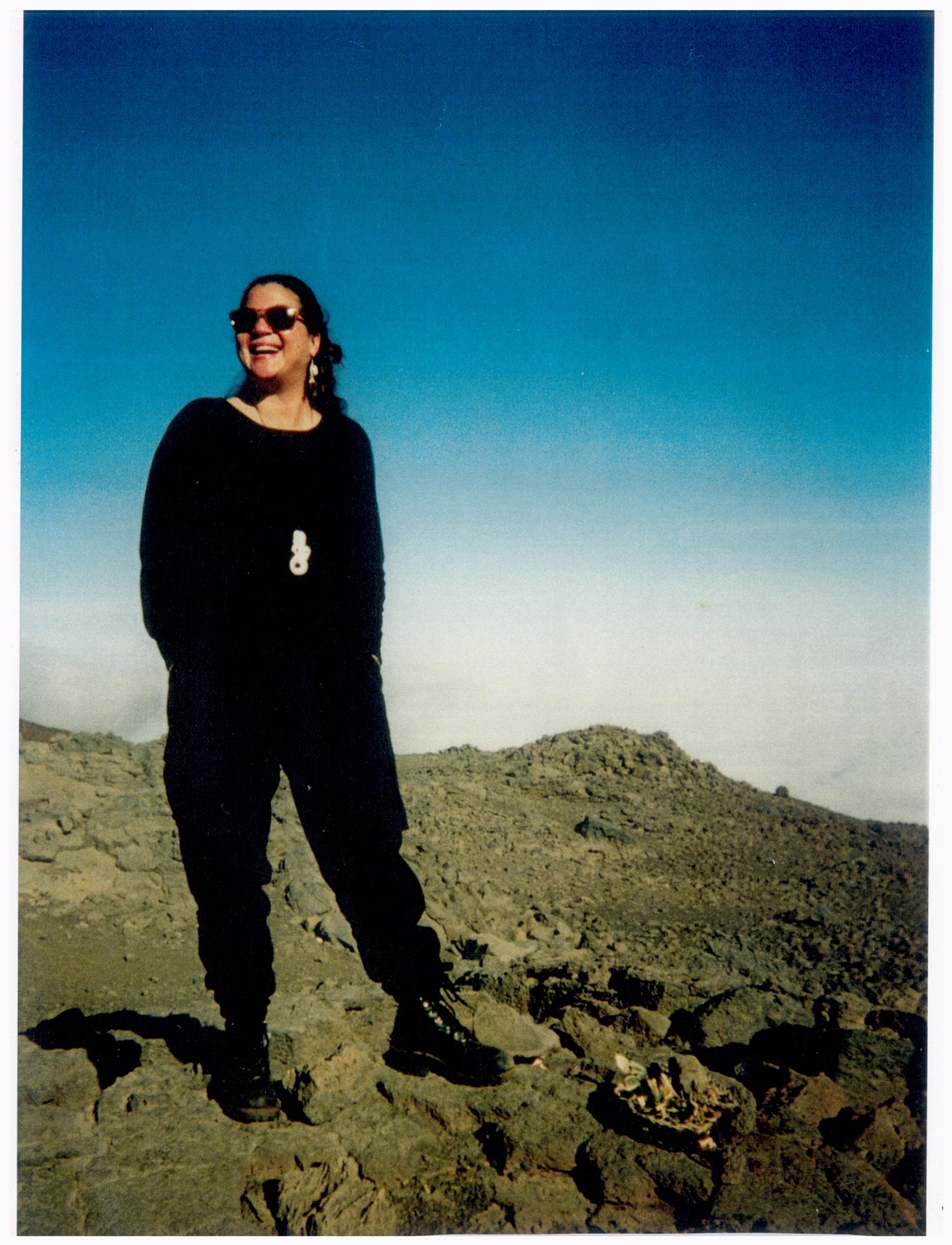
Kealoha Pisciotta stands on Mauna Kea near her family ahu.
Photo courtesy of Kealoha Pisciotta
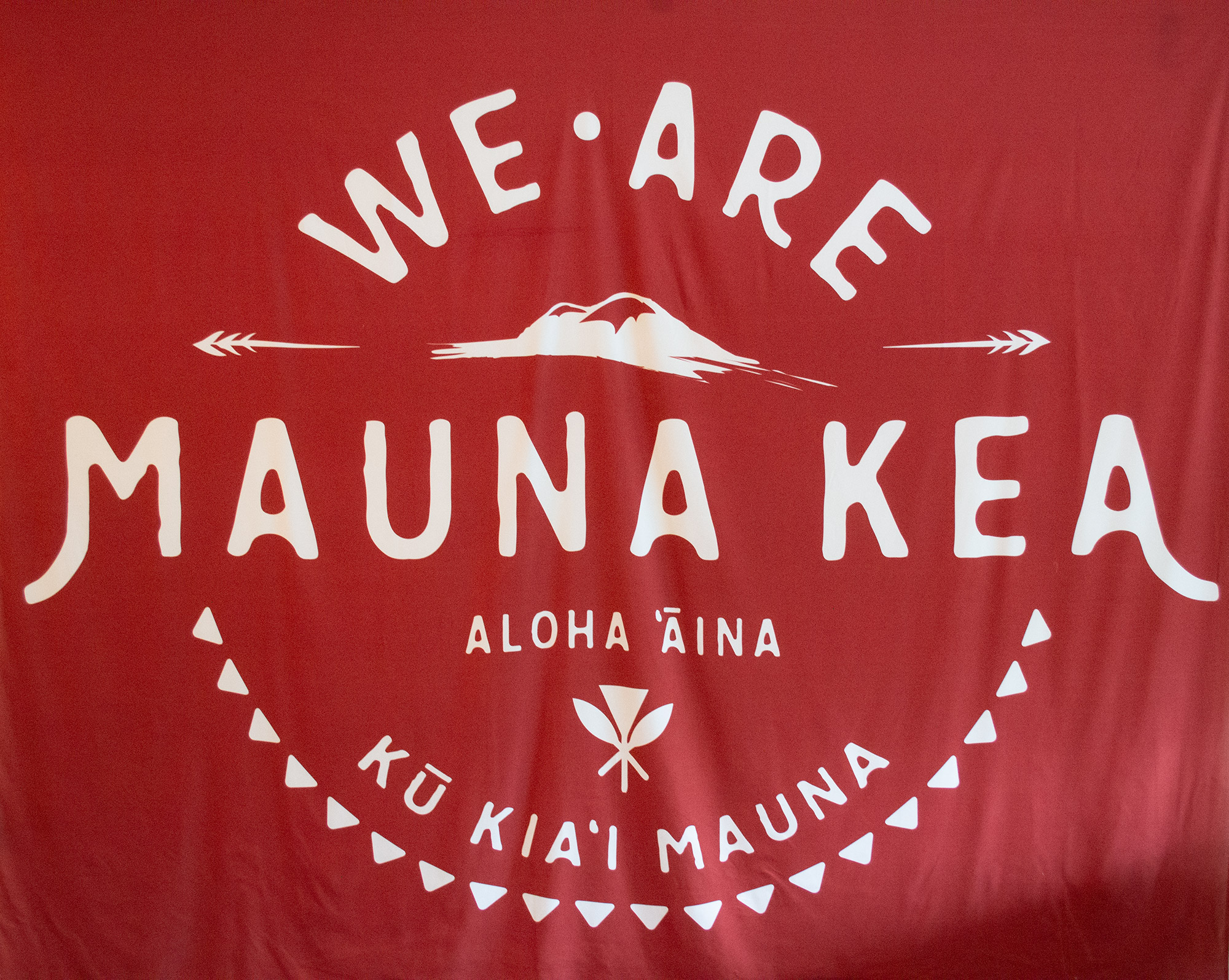
Photo by Chelsea Steinauer-Scudder
This has become the central question in the fight against development on Mauna Kea—one that, in the end, has very little to do with astronomy or TMT: to what extent is this about imposing a fallible human perception, informed by a modern idea of progress, onto the land in ways that will alter that land from what it has been for millions of years? When must the modern agenda make the choice to bow in reverence to creation?
For Kealoha, the Kumulipo says that aloha is codified in the land. “It gives instruction to us as modern humans of how we’re supposed to live. We’re not the supreme entity. We’re part of all the life that unfolded, even before us, and [that] will continue to unfold now.… That fallacy that we’re one, superior, and, two, that we’re separate from nature, has got to stop, because that’s not the old way. Not just the old Hawai’ian way, it’s not the old way of humanity. I want to argue and continue arguing that creation still continues—it’s just that no one is singing the song. Except perhaps the whales.”
As she and others have continued the process of remembering the traditions, they’ve had to find language for conveying their spirituality in formal, Western settings such as the courtroom. “Many of these stories are super ancient,” Kealoha says. “So when we’re re-bringing them forward, it’s awkward because we’re not sure. We’re emerging out of our colonization as a people. Coming back into that is uncertain.” It is easy to see this uncertainty in reading through the testimonies against TMT. Attempting to bring old ways of knowing into a modern courtroom did little to sway the board’s decision on permitting TMT. You can sense the dismissiveness with which the board endured these testimonies in their final written decision, and it’s easy to wonder if the petitioners felt the same futility as Queen Lili’uokalani felt in 1893—a lack of control in the face of an utterly different way of thinking.
In order to be heard as legitimate Native practitioners, petitioners to the BLNR had to both prove their genealogy as Kanaka Maoli and that the cultural practices of their ancestors on Mauna Kea dated back to at least 1892. This information, of course, has been lost for many. Even when someone could prove this, lawyers for TMT and the University were quick to ask where specifically they practice and where their ancestors practiced. If they were unable to prove that they practiced directly on the proposed site of TMT, the lawyers asked, how then could they prove that the telescopes would disrupt their tradition of practice? In the testimonies recorded on video, you can see the testifier flounder, as if trying to work out some legal terminology to convey it’s not a matter of where on the mountain they practice, it’s that the entire mountain, and particularly the area of the summit, is a sacred site. This argument holds no water for the legal context in which the board is considering the permit—in the end, the BLNR has remained unconvinced by such testimony. As the BLNR wrote in its final decision, approving TMT: “Some Native Hawai’ians expressed that Mauna Kea is so sacred that the very idea of a large structure is offensive. But there are already twelve observatories on Mauna Kea, some of them almost as large as the TMT. They will remain even if the TMT is not built. No credible evidence was presented that the TMT would somehow be worse from a spiritual or cultural point of view than the other large observatories.”
The University of Hawai’i and TMT, on the other hand, came to the BLNR with scientific data, long lists of impressive astronomical discoveries, and scholarship money for local students. They came speaking the language of the modern Western framework. They had answers for all of the BLNR’s questions, and the board easily understood their answers. As they write:
TMT will contribute $1 million a year toward education, and has signed a sublease agreement committing $300,000/yr. at first, increasing to $1 million/yr., for conservation on Mauna Kea. No existing observatory makes any such contributions. Astronomy directly supports about 1,000 jobs in Hawai’i. TMT will employ about 140 people.… Astronomers discovered that the earth goes around the sun; that we live in one of more than 100 billion galaxies; that our universe expanded from a single point 13.7 billion years ago. These discoveries shape how we see our place in the universe. Other telescopes on Mauna Kea have already contributed to human knowledge. TMT, if built, will do the same.
In what one can only imagine was one of the most infuriating aspects of the process, the board proceeded to take the Kanaka Maoli cosmology, as well as much of what the petitioners used in arguing that TMT would desecrate a sacred site, and used it to justify the construction of TMT: “One Native Hawai’ian story about the origin of Mauna Kea is that Wākea, ‘Sky Father,’ and Papa, ‘Earth Mother,’ created a child, Hawai’i Island. Mauna Kea is the highest summit of the island, this union of heaven and earth. Today, Mauna Kea is the best place on earth to study the heavens.”
Multiple facets of the approval have become snared in the higher courts. The Flores-Case Ohana brought their appeal of the BLNR’s decision to approve the sublease for TMT to the State Supreme Court. In August 2018, the court unanimously ruled against the Flores-Case Ohana. Multiple petitioners have also appealed the board’s approval of the land use permit, and for now, all sides await the Hawai’i Supreme Court’s ruling. No matter the outcome of the ruling, Pua, Kealoha, Paul, Lanakila, and many others will continue to fight for the summit, both in the courts and out. Alongside them, many of the Kanaka Maoli are remembering and relearning the chants and the true meaning of aloha. Though they have not found much legal standing for this worldview within modern Hawai’i, it has helped to awaken a sense of kuleana, personal responsibility, to the land and to each other. They are singing the chants and dancing hula. Increasingly, they are doing it together.
“That’s why Mauna Kea is important,” Kealoha says. “This brings it back to what it symbolizes for our people as our origin place, as our place of understanding the universe properly, as a way to be healed and to heal. [It is a way] to speak from a place of divine understanding that teaches all of humanity to be humble, to know that there is always something greater than ourselves. Mauna Kea calls upon us to be our highest self. Even when we’re uncertain of what that looks like, we just have to open our heart and rely on the goodness in it and the goodness that is inspiring us to move…. Maybe people still hold us as these nice people in the Pacific that make luaus and dance hula, but we have an important role to play as the guardians of—and keepers of—the principles of aloha.”
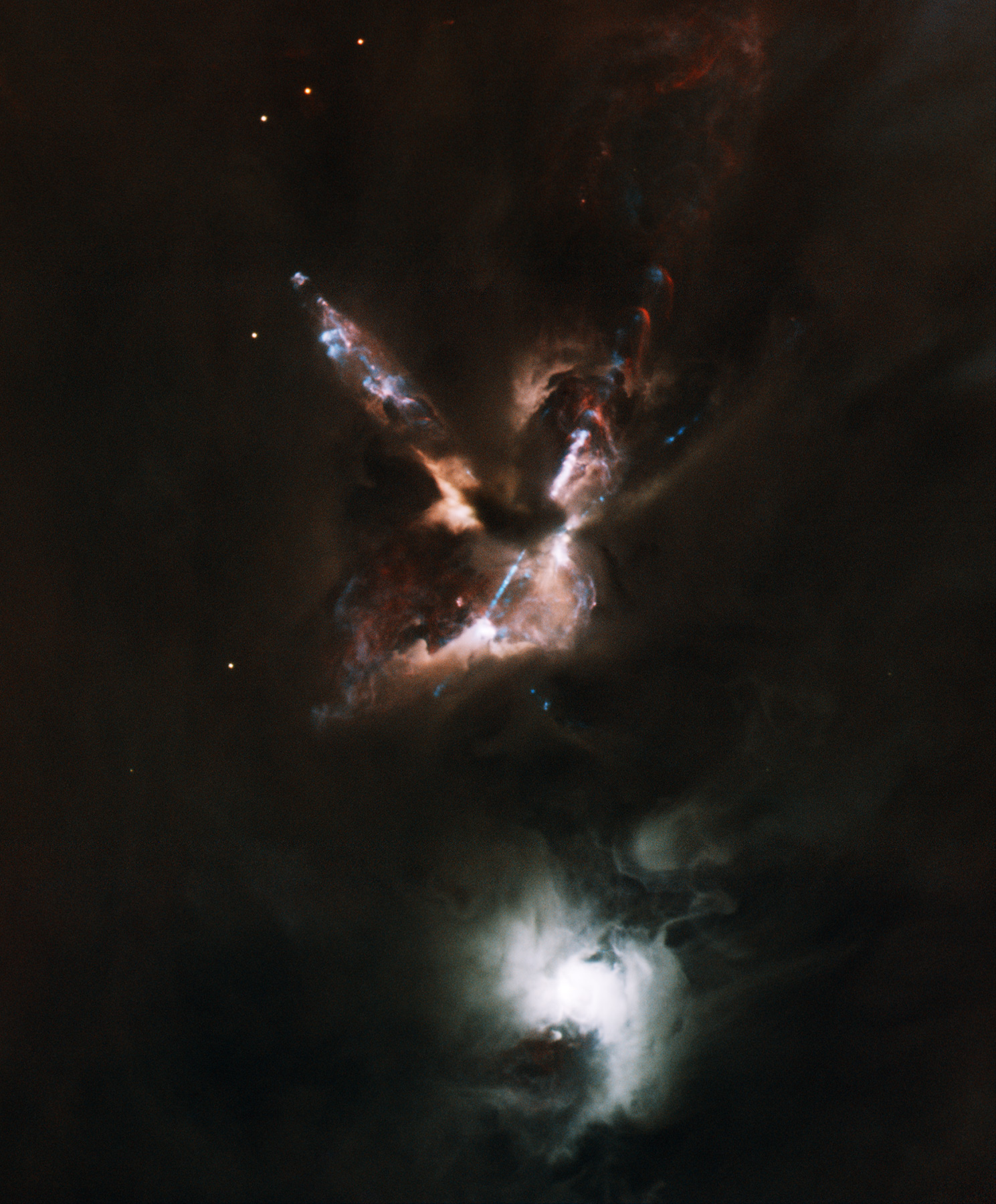
An image of Star-birth “fireworks” captured by Gemini Observatory.
Gemini Observatory/AURA/B. Reipurth, C. Aspin, T. Rector
The drive from Hilo to the summit of Mauna Kea is just over an hour—seemingly quick given how much the landscape changed along the way. Suddenly I am through and above the clouds, and all the visible plants are gone, replaced with snow and ice, steep hills, and wide craters of red and black earth. I stop at the Visitor Information Station for the recommended acclimation break and a safety briefing, and forty-five minutes later drive the rest of the way up the access road to the nearly 14,000-foot summit.
Inside the dome of Gemini Observatory, I am astounded that something this huge could be called a telescope. We’ve just taken an elevator up several floors to reach the dome, which looks more like the set of a Star Trek episode than a site for modern astronomy. Bright lights line the circular perimeter of the white room, which rises yet another several stories. Metallic boxes of electrical equipment are everywhere, and bright blue scaffolding climbs from the floor, its purpose undefinable for the astronomy novice. When the dome begins to rotate, I lose the few bearings I have left. I can’t tell if the dome is rotating, or the floor, or both.
Gemini Observatory consists of twin optical telescopes in the Northern and Southern Hemispheres, one on Mauna Kea and one in the Chilean Andes, that are operated via an international partnership that includes the United States, Brazil, Chile, Canada, and Argentina. At the Gemini base facility in Hilo, Peter Michaud, Gemini’s outreach manager, told me that the idea that their telescope is on the summit of the mountain is a common misconception. “We’re not on the summit of Mauna Kea,” said Michaud. “We’re near the summit of Mauna Kea. We’re in the summit area…. I know the whole summit area is sensitive culturally, but we’re not actually on the summit. We would never build on the summit.” Such a misunderstanding is partly due, perhaps, to the fact that even the Gemini website boasts of its observatory on the summit of Mauna Kea.
Stepping out of the telescope into the frigid air and strong sun, it seems only hubris to attempt to draw boundaries across the top of this mountain with semantics. The word summit has nothing to say about the procession of clouds being pulled across the sky, the silent cinder cones that once breathed fire, the birth of a mountain from the depths of the ocean.
The “true summit” is a few hundred yards away from Gemini. I walk the short distance and make my way up the slope, remembering to take my time when my heart and head begin to pound, recalling with a jolt of fear what several Kanaka Maoli had cautioned: the mountain can take your breath. The wind picks up as I step carefully along the thin trail, leading to the highest point in the Pacific Ocean. Here at the top is the ahu, the stone shrine. In one direction, it faces a great expanse of clouds, where million-year-old rocks meet the eternity of the sky. Offerings placed between the stones suggest that someone has been here recently. Perhaps they danced hula, their feet on the rocky ground, chanting songs that recall the relationship between land and sky, human and mountain.
The sun is fleeing quickly now, revealing night’s first stars. They shine through the frigid air, their delicate and ancient light seeming to at once secure your feet on the ground and tug your spirit upward, whispering to you precisely where you are and permitting you to glimpse an infinite realm.
Turning to walk back to the access road, I see a cluster of structures made of metal and concrete—dark silhouettes against a deep blue. The astronomers are far below, busy assembling the puzzles of data brought in nightly by the seeing eyes of telescopes that bring our gaze ever further upward, far and away from the White Mountain that stands, now and for many eons more, here at the cusp of heaven and earth.
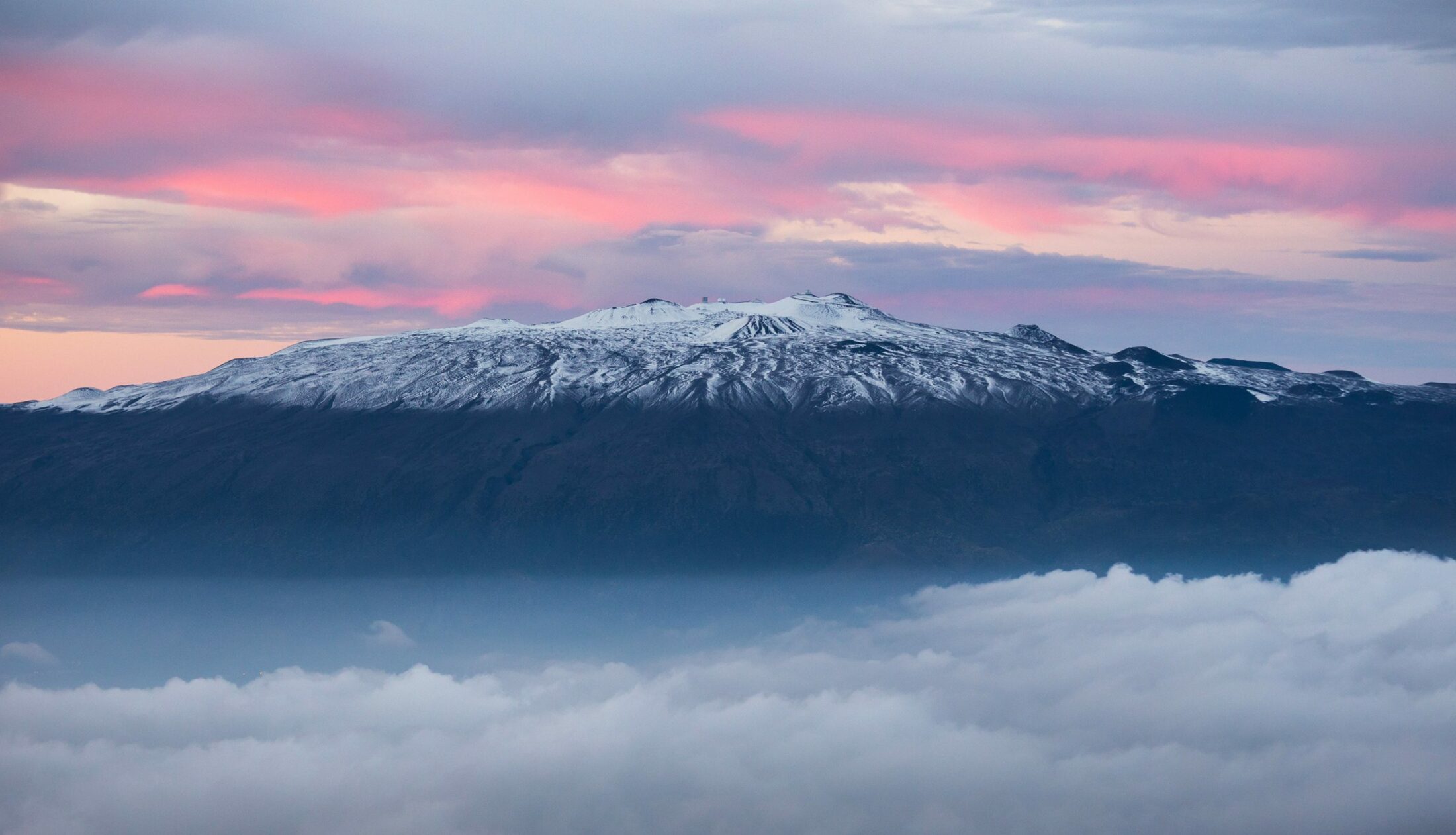
Photo by Sean Goebel
Addendum
On October 30, 2018, the Hawai’i Supreme Court ruled in favor of TMT in a 4–1 decision, approving the BLNR’s issuance of the conservation use application permit, further codifying a worldview in which sacredness is a matter of Western precedent and calculation:
Native Hawai’ian rights were not found to have been exercised in the relevant area.
“It’s far from over,” says Pua. She will regroup in the hope that the Kanaka Maoli will only become stronger, further united. For Kealoha, the system has failed. But she says, “Maybe this causes people to rise up in goodness, in aloha…. We have vowed to continue in our path of aloha. That means taking right actions and speaking to that truth that is meant to heal. We won’t change that…. In the end we will pray and honor the Sacred Nature of the Mauna and go where Aloha takes us.”
The two will continue to stand—with thousands beside them—like the mountain, for the mountain, with the mountain.
